(Solution) Human Resource Management: Assignment
VerifiedAdded on 2021/06/14
|38
|11369
|47
AI Summary
Contribute Materials
Your contribution can guide someone’s learning journey. Share your
documents today.
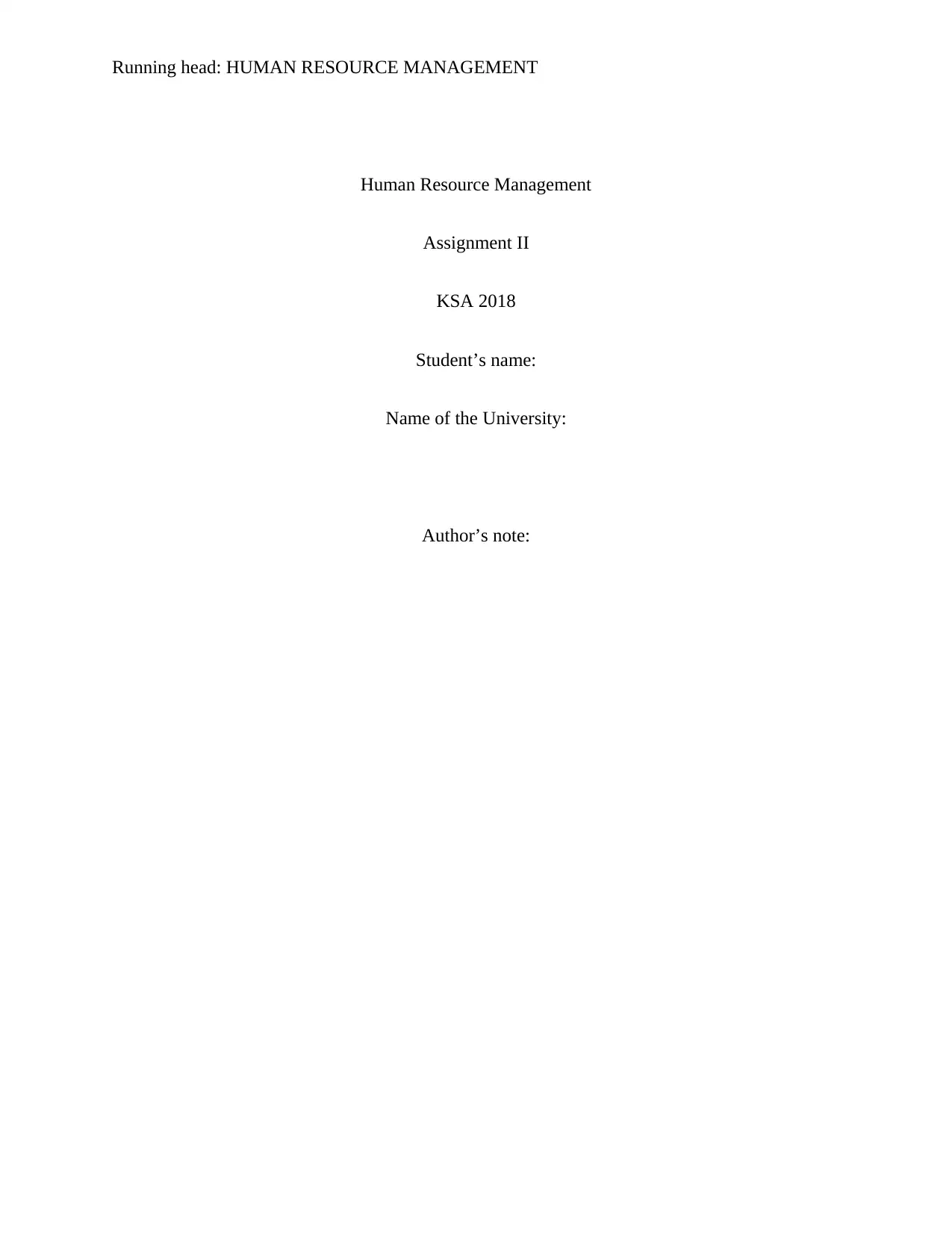
Running head: HUMAN RESOURCE MANAGEMENT
Human Resource Management
Assignment II
KSA 2018
Student’s name:
Name of the University:
Author’s note:
Human Resource Management
Assignment II
KSA 2018
Student’s name:
Name of the University:
Author’s note:
Secure Best Marks with AI Grader
Need help grading? Try our AI Grader for instant feedback on your assignments.
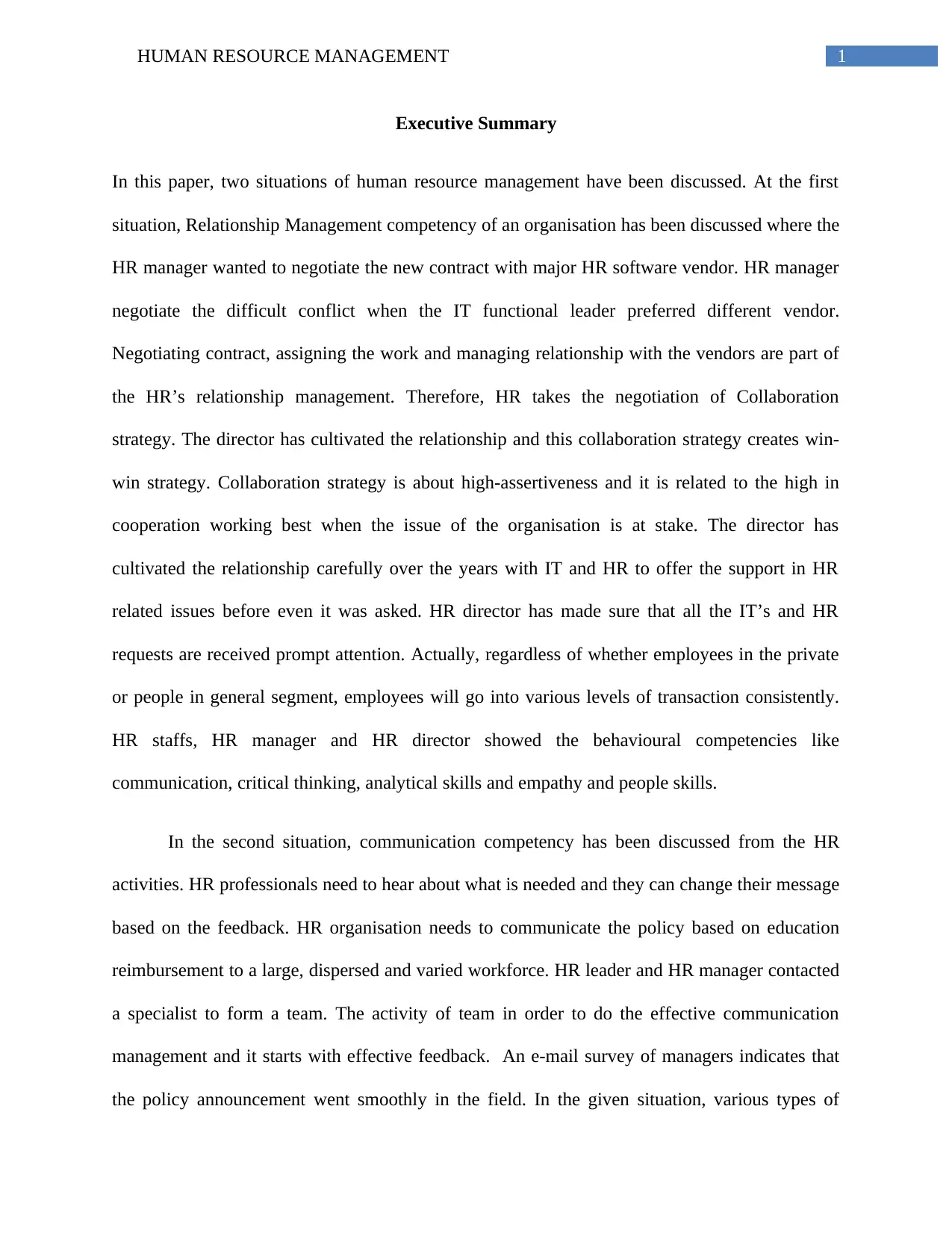
1HUMAN RESOURCE MANAGEMENT
Executive Summary
In this paper, two situations of human resource management have been discussed. At the first
situation, Relationship Management competency of an organisation has been discussed where the
HR manager wanted to negotiate the new contract with major HR software vendor. HR manager
negotiate the difficult conflict when the IT functional leader preferred different vendor.
Negotiating contract, assigning the work and managing relationship with the vendors are part of
the HR’s relationship management. Therefore, HR takes the negotiation of Collaboration
strategy. The director has cultivated the relationship and this collaboration strategy creates win-
win strategy. Collaboration strategy is about high-assertiveness and it is related to the high in
cooperation working best when the issue of the organisation is at stake. The director has
cultivated the relationship carefully over the years with IT and HR to offer the support in HR
related issues before even it was asked. HR director has made sure that all the IT’s and HR
requests are received prompt attention. Actually, regardless of whether employees in the private
or people in general segment, employees will go into various levels of transaction consistently.
HR staffs, HR manager and HR director showed the behavioural competencies like
communication, critical thinking, analytical skills and empathy and people skills.
In the second situation, communication competency has been discussed from the HR
activities. HR professionals need to hear about what is needed and they can change their message
based on the feedback. HR organisation needs to communicate the policy based on education
reimbursement to a large, dispersed and varied workforce. HR leader and HR manager contacted
a specialist to form a team. The activity of team in order to do the effective communication
management and it starts with effective feedback. An e-mail survey of managers indicates that
the policy announcement went smoothly in the field. In the given situation, various types of
Executive Summary
In this paper, two situations of human resource management have been discussed. At the first
situation, Relationship Management competency of an organisation has been discussed where the
HR manager wanted to negotiate the new contract with major HR software vendor. HR manager
negotiate the difficult conflict when the IT functional leader preferred different vendor.
Negotiating contract, assigning the work and managing relationship with the vendors are part of
the HR’s relationship management. Therefore, HR takes the negotiation of Collaboration
strategy. The director has cultivated the relationship and this collaboration strategy creates win-
win strategy. Collaboration strategy is about high-assertiveness and it is related to the high in
cooperation working best when the issue of the organisation is at stake. The director has
cultivated the relationship carefully over the years with IT and HR to offer the support in HR
related issues before even it was asked. HR director has made sure that all the IT’s and HR
requests are received prompt attention. Actually, regardless of whether employees in the private
or people in general segment, employees will go into various levels of transaction consistently.
HR staffs, HR manager and HR director showed the behavioural competencies like
communication, critical thinking, analytical skills and empathy and people skills.
In the second situation, communication competency has been discussed from the HR
activities. HR professionals need to hear about what is needed and they can change their message
based on the feedback. HR organisation needs to communicate the policy based on education
reimbursement to a large, dispersed and varied workforce. HR leader and HR manager contacted
a specialist to form a team. The activity of team in order to do the effective communication
management and it starts with effective feedback. An e-mail survey of managers indicates that
the policy announcement went smoothly in the field. In the given situation, various types of

2HUMAN RESOURCE MANAGEMENT
communication like verbal and written communication have been shown. Mainly informal as
well as formal communication has been cleared. In the workplace, non-verbal communication
can also help avoid giving off the same impression. Especially in situations where people may
not be able to avoid feeling nervous at the moment. E-mail communication technology, e-mail
survey, web conference and intranet communication have been used in the given situation. In
addition, feedback from the clients, vendors and suppliers are important to build a better
relationship with external stakeholders.
communication like verbal and written communication have been shown. Mainly informal as
well as formal communication has been cleared. In the workplace, non-verbal communication
can also help avoid giving off the same impression. Especially in situations where people may
not be able to avoid feeling nervous at the moment. E-mail communication technology, e-mail
survey, web conference and intranet communication have been used in the given situation. In
addition, feedback from the clients, vendors and suppliers are important to build a better
relationship with external stakeholders.

3HUMAN RESOURCE MANAGEMENT
Table of Contents
The situation....................................................................................................................................3
Question 1: Where do you see the Relationship Management competency being used?............3
Question 2: What is the rationale for laying the groundwork with the vendor?..........................6
Question 3: What type of conflict resolution strategy is used here? Why is it appropriate?.......9
Question 4: What important role does the HR director play?...................................................11
Question 5: What other Behavioural Competencies do you see being used?............................13
The Situation..................................................................................................................................16
Question 1: What is the advantage of using a team to tackle this communication? Apply
different communication management principles and activities to this situation......................16
Question 2: What is the advantage of breaking the communication into multiple segments?. .19
Question 3: What are the advantages of the communication technologies used in this case?. .22
Question 4: How is this communication improved through feedback? What impact does cross
culture has on communication...................................................................................................26
Reference List................................................................................................................................30
Table of Contents
The situation....................................................................................................................................3
Question 1: Where do you see the Relationship Management competency being used?............3
Question 2: What is the rationale for laying the groundwork with the vendor?..........................6
Question 3: What type of conflict resolution strategy is used here? Why is it appropriate?.......9
Question 4: What important role does the HR director play?...................................................11
Question 5: What other Behavioural Competencies do you see being used?............................13
The Situation..................................................................................................................................16
Question 1: What is the advantage of using a team to tackle this communication? Apply
different communication management principles and activities to this situation......................16
Question 2: What is the advantage of breaking the communication into multiple segments?. .19
Question 3: What are the advantages of the communication technologies used in this case?. .22
Question 4: How is this communication improved through feedback? What impact does cross
culture has on communication...................................................................................................26
Reference List................................................................................................................................30
Paraphrase This Document
Need a fresh take? Get an instant paraphrase of this document with our AI Paraphraser

4HUMAN RESOURCE MANAGEMENT
The situation
Question 1: Where do you see the Relationship Management competency being used?
Relationship Management is the ability to manage overall interaction to provide the
service to support the organisation. HR professionals must have the ability to manage the
interaction and it is the function of the ability to maintain the productive interpersonal
relationship to help others in the workplace (Kumar and Reinartz 2018). It is very important for
HR professionals to do the basics right. In order to be a strategic business partner within an
organisation; it is significant to know the right people and to establish and manage the key
relationship between a right person and the organisation. The effective HR leaders within the
organisation understand the significance of alliance in order to influence the behaviour of the
people to overcome the resistance.
The HR leaders can use Relationship Management in order to implement diversity and
inclusion strategy. Diversity and inclusion is the company’s strategy, mission and practice to
have the diverse workplace. The HR professionals must leverage the effect of diversity in order
to gain the competitive business advantage. In addition, the HR leaders can make the relationship
management with the employees and individuals with the top diversity as well as inclusion
priority for recruitment of the diverse employees within the organisation. Therefore, Relationship
Management should be present for the employees where the HR department can use this while
recruiting the new employees.
Establishing the effective relationship with the supervisor is another place where the HR
professionals and the employees need the skill of Relationship Management. Basic
understanding of Relationship Management can help to apply the competency of the routine
The situation
Question 1: Where do you see the Relationship Management competency being used?
Relationship Management is the ability to manage overall interaction to provide the
service to support the organisation. HR professionals must have the ability to manage the
interaction and it is the function of the ability to maintain the productive interpersonal
relationship to help others in the workplace (Kumar and Reinartz 2018). It is very important for
HR professionals to do the basics right. In order to be a strategic business partner within an
organisation; it is significant to know the right people and to establish and manage the key
relationship between a right person and the organisation. The effective HR leaders within the
organisation understand the significance of alliance in order to influence the behaviour of the
people to overcome the resistance.
The HR leaders can use Relationship Management in order to implement diversity and
inclusion strategy. Diversity and inclusion is the company’s strategy, mission and practice to
have the diverse workplace. The HR professionals must leverage the effect of diversity in order
to gain the competitive business advantage. In addition, the HR leaders can make the relationship
management with the employees and individuals with the top diversity as well as inclusion
priority for recruitment of the diverse employees within the organisation. Therefore, Relationship
Management should be present for the employees where the HR department can use this while
recruiting the new employees.
Establishing the effective relationship with the supervisor is another place where the HR
professionals and the employees need the skill of Relationship Management. Basic
understanding of Relationship Management can help to apply the competency of the routine
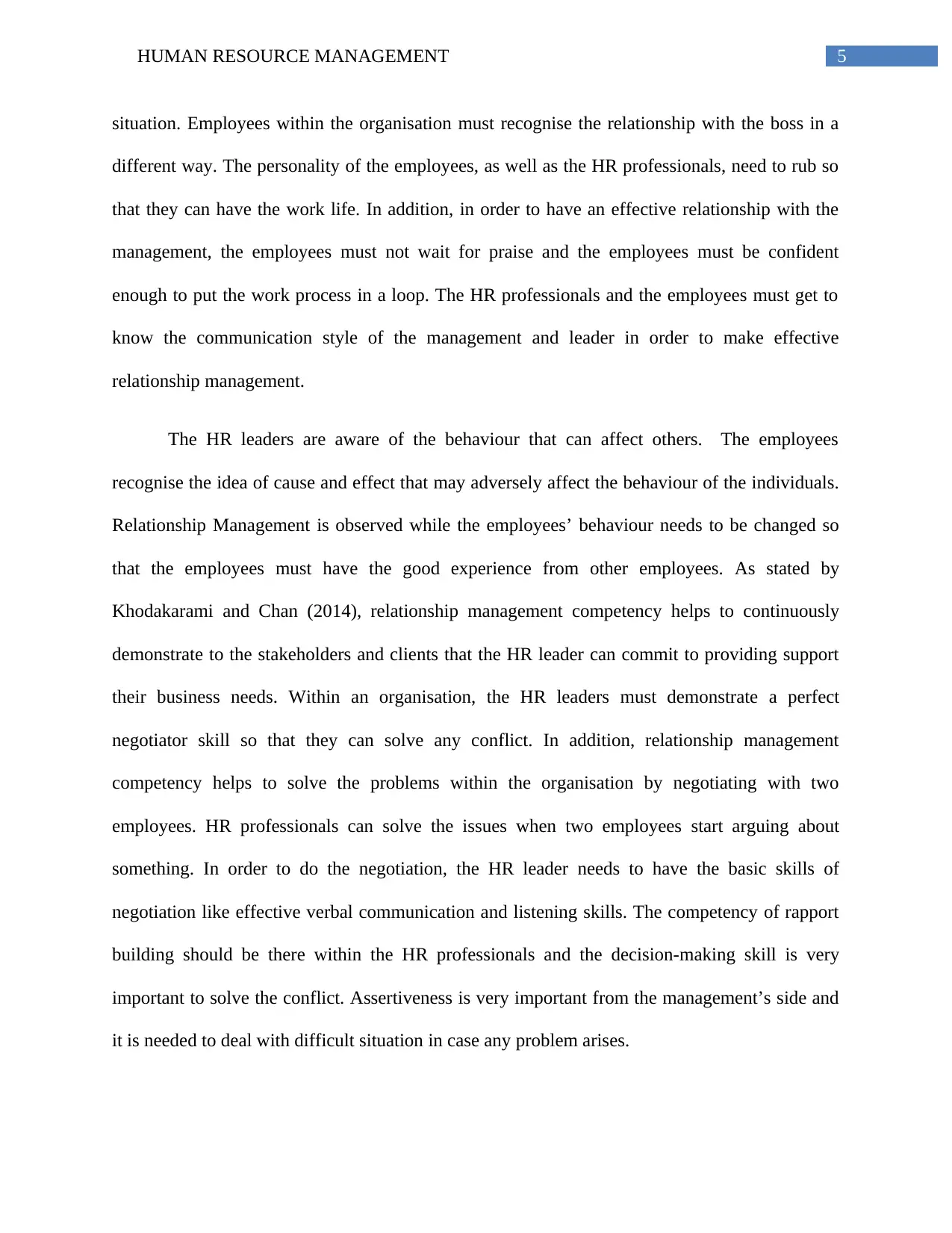
5HUMAN RESOURCE MANAGEMENT
situation. Employees within the organisation must recognise the relationship with the boss in a
different way. The personality of the employees, as well as the HR professionals, need to rub so
that they can have the work life. In addition, in order to have an effective relationship with the
management, the employees must not wait for praise and the employees must be confident
enough to put the work process in a loop. The HR professionals and the employees must get to
know the communication style of the management and leader in order to make effective
relationship management.
The HR leaders are aware of the behaviour that can affect others. The employees
recognise the idea of cause and effect that may adversely affect the behaviour of the individuals.
Relationship Management is observed while the employees’ behaviour needs to be changed so
that the employees must have the good experience from other employees. As stated by
Khodakarami and Chan (2014), relationship management competency helps to continuously
demonstrate to the stakeholders and clients that the HR leader can commit to providing support
their business needs. Within an organisation, the HR leaders must demonstrate a perfect
negotiator skill so that they can solve any conflict. In addition, relationship management
competency helps to solve the problems within the organisation by negotiating with two
employees. HR professionals can solve the issues when two employees start arguing about
something. In order to do the negotiation, the HR leader needs to have the basic skills of
negotiation like effective verbal communication and listening skills. The competency of rapport
building should be there within the HR professionals and the decision-making skill is very
important to solve the conflict. Assertiveness is very important from the management’s side and
it is needed to deal with difficult situation in case any problem arises.
situation. Employees within the organisation must recognise the relationship with the boss in a
different way. The personality of the employees, as well as the HR professionals, need to rub so
that they can have the work life. In addition, in order to have an effective relationship with the
management, the employees must not wait for praise and the employees must be confident
enough to put the work process in a loop. The HR professionals and the employees must get to
know the communication style of the management and leader in order to make effective
relationship management.
The HR leaders are aware of the behaviour that can affect others. The employees
recognise the idea of cause and effect that may adversely affect the behaviour of the individuals.
Relationship Management is observed while the employees’ behaviour needs to be changed so
that the employees must have the good experience from other employees. As stated by
Khodakarami and Chan (2014), relationship management competency helps to continuously
demonstrate to the stakeholders and clients that the HR leader can commit to providing support
their business needs. Within an organisation, the HR leaders must demonstrate a perfect
negotiator skill so that they can solve any conflict. In addition, relationship management
competency helps to solve the problems within the organisation by negotiating with two
employees. HR professionals can solve the issues when two employees start arguing about
something. In order to do the negotiation, the HR leader needs to have the basic skills of
negotiation like effective verbal communication and listening skills. The competency of rapport
building should be there within the HR professionals and the decision-making skill is very
important to solve the conflict. Assertiveness is very important from the management’s side and
it is needed to deal with difficult situation in case any problem arises.
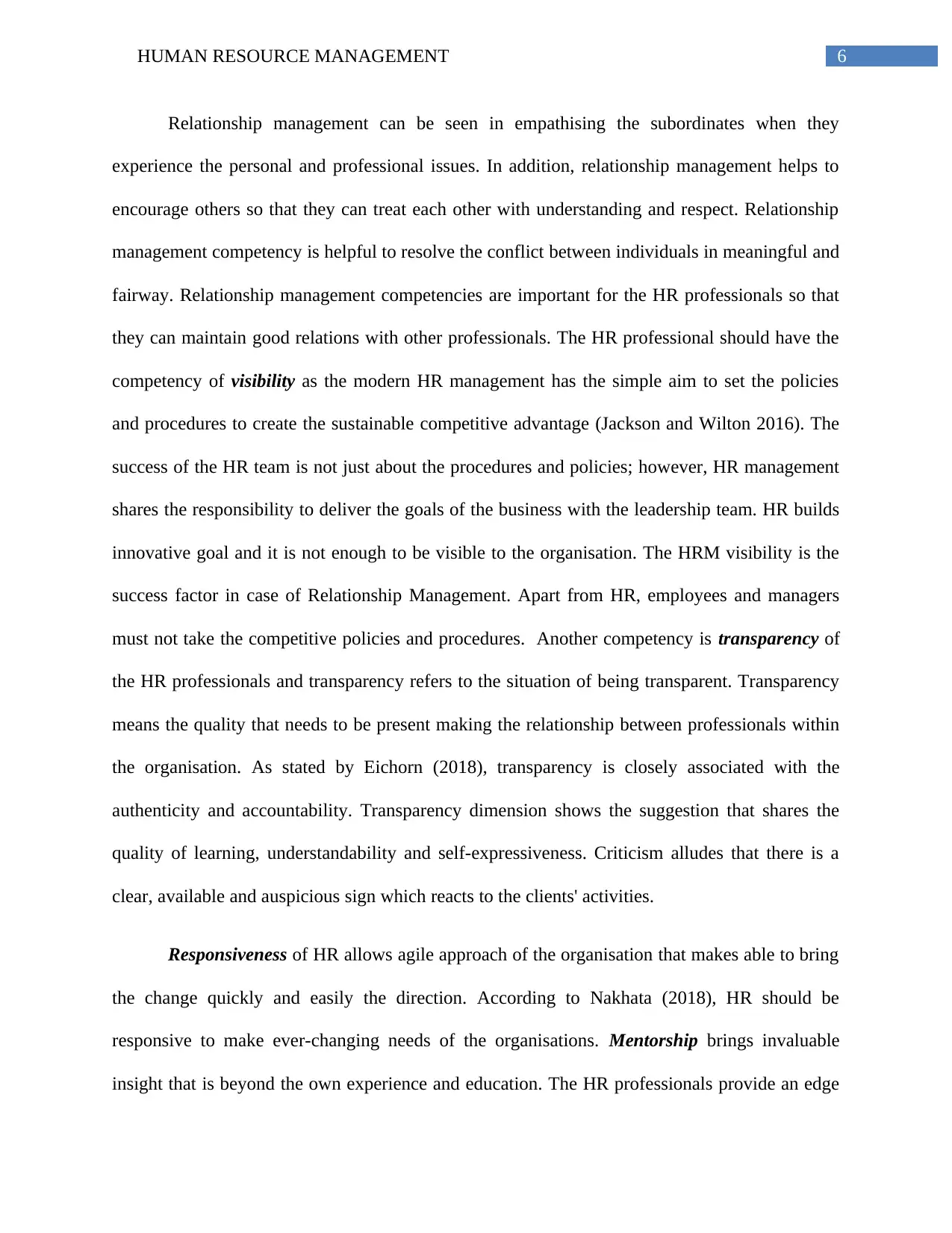
6HUMAN RESOURCE MANAGEMENT
Relationship management can be seen in empathising the subordinates when they
experience the personal and professional issues. In addition, relationship management helps to
encourage others so that they can treat each other with understanding and respect. Relationship
management competency is helpful to resolve the conflict between individuals in meaningful and
fairway. Relationship management competencies are important for the HR professionals so that
they can maintain good relations with other professionals. The HR professional should have the
competency of visibility as the modern HR management has the simple aim to set the policies
and procedures to create the sustainable competitive advantage (Jackson and Wilton 2016). The
success of the HR team is not just about the procedures and policies; however, HR management
shares the responsibility to deliver the goals of the business with the leadership team. HR builds
innovative goal and it is not enough to be visible to the organisation. The HRM visibility is the
success factor in case of Relationship Management. Apart from HR, employees and managers
must not take the competitive policies and procedures. Another competency is transparency of
the HR professionals and transparency refers to the situation of being transparent. Transparency
means the quality that needs to be present making the relationship between professionals within
the organisation. As stated by Eichorn (2018), transparency is closely associated with the
authenticity and accountability. Transparency dimension shows the suggestion that shares the
quality of learning, understandability and self-expressiveness. Criticism alludes that there is a
clear, available and auspicious sign which reacts to the clients' activities.
Responsiveness of HR allows agile approach of the organisation that makes able to bring
the change quickly and easily the direction. According to Nakhata (2018), HR should be
responsive to make ever-changing needs of the organisations. Mentorship brings invaluable
insight that is beyond the own experience and education. The HR professionals provide an edge
Relationship management can be seen in empathising the subordinates when they
experience the personal and professional issues. In addition, relationship management helps to
encourage others so that they can treat each other with understanding and respect. Relationship
management competency is helpful to resolve the conflict between individuals in meaningful and
fairway. Relationship management competencies are important for the HR professionals so that
they can maintain good relations with other professionals. The HR professional should have the
competency of visibility as the modern HR management has the simple aim to set the policies
and procedures to create the sustainable competitive advantage (Jackson and Wilton 2016). The
success of the HR team is not just about the procedures and policies; however, HR management
shares the responsibility to deliver the goals of the business with the leadership team. HR builds
innovative goal and it is not enough to be visible to the organisation. The HRM visibility is the
success factor in case of Relationship Management. Apart from HR, employees and managers
must not take the competitive policies and procedures. Another competency is transparency of
the HR professionals and transparency refers to the situation of being transparent. Transparency
means the quality that needs to be present making the relationship between professionals within
the organisation. As stated by Eichorn (2018), transparency is closely associated with the
authenticity and accountability. Transparency dimension shows the suggestion that shares the
quality of learning, understandability and self-expressiveness. Criticism alludes that there is a
clear, available and auspicious sign which reacts to the clients' activities.
Responsiveness of HR allows agile approach of the organisation that makes able to bring
the change quickly and easily the direction. According to Nakhata (2018), HR should be
responsive to make ever-changing needs of the organisations. Mentorship brings invaluable
insight that is beyond the own experience and education. The HR professionals provide an edge
Secure Best Marks with AI Grader
Need help grading? Try our AI Grader for instant feedback on your assignments.
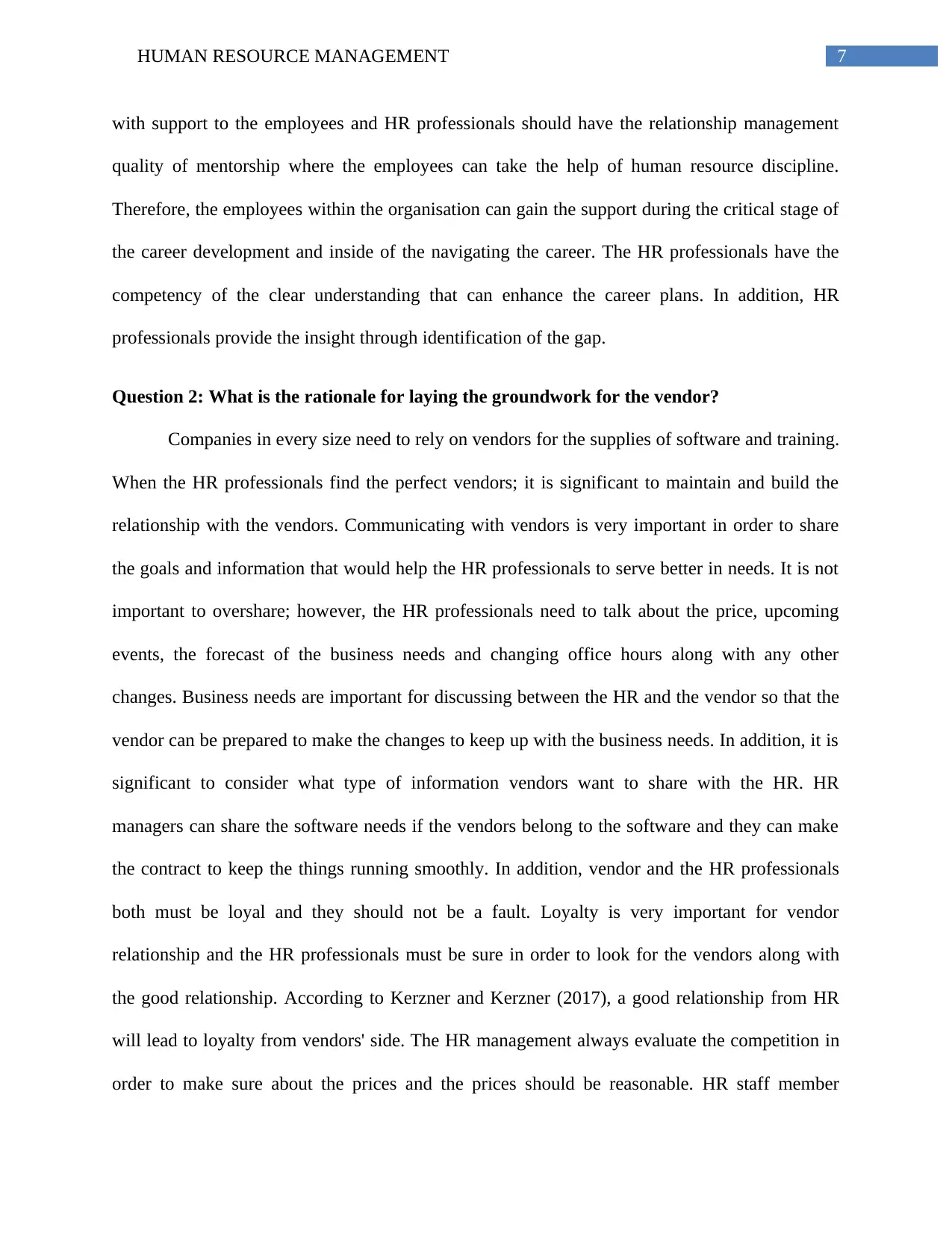
7HUMAN RESOURCE MANAGEMENT
with support to the employees and HR professionals should have the relationship management
quality of mentorship where the employees can take the help of human resource discipline.
Therefore, the employees within the organisation can gain the support during the critical stage of
the career development and inside of the navigating the career. The HR professionals have the
competency of the clear understanding that can enhance the career plans. In addition, HR
professionals provide the insight through identification of the gap.
Question 2: What is the rationale for laying the groundwork for the vendor?
Companies in every size need to rely on vendors for the supplies of software and training.
When the HR professionals find the perfect vendors; it is significant to maintain and build the
relationship with the vendors. Communicating with vendors is very important in order to share
the goals and information that would help the HR professionals to serve better in needs. It is not
important to overshare; however, the HR professionals need to talk about the price, upcoming
events, the forecast of the business needs and changing office hours along with any other
changes. Business needs are important for discussing between the HR and the vendor so that the
vendor can be prepared to make the changes to keep up with the business needs. In addition, it is
significant to consider what type of information vendors want to share with the HR. HR
managers can share the software needs if the vendors belong to the software and they can make
the contract to keep the things running smoothly. In addition, vendor and the HR professionals
both must be loyal and they should not be a fault. Loyalty is very important for vendor
relationship and the HR professionals must be sure in order to look for the vendors along with
the good relationship. According to Kerzner and Kerzner (2017), a good relationship from HR
will lead to loyalty from vendors' side. The HR management always evaluate the competition in
order to make sure about the prices and the prices should be reasonable. HR staff member
with support to the employees and HR professionals should have the relationship management
quality of mentorship where the employees can take the help of human resource discipline.
Therefore, the employees within the organisation can gain the support during the critical stage of
the career development and inside of the navigating the career. The HR professionals have the
competency of the clear understanding that can enhance the career plans. In addition, HR
professionals provide the insight through identification of the gap.
Question 2: What is the rationale for laying the groundwork for the vendor?
Companies in every size need to rely on vendors for the supplies of software and training.
When the HR professionals find the perfect vendors; it is significant to maintain and build the
relationship with the vendors. Communicating with vendors is very important in order to share
the goals and information that would help the HR professionals to serve better in needs. It is not
important to overshare; however, the HR professionals need to talk about the price, upcoming
events, the forecast of the business needs and changing office hours along with any other
changes. Business needs are important for discussing between the HR and the vendor so that the
vendor can be prepared to make the changes to keep up with the business needs. In addition, it is
significant to consider what type of information vendors want to share with the HR. HR
managers can share the software needs if the vendors belong to the software and they can make
the contract to keep the things running smoothly. In addition, vendor and the HR professionals
both must be loyal and they should not be a fault. Loyalty is very important for vendor
relationship and the HR professionals must be sure in order to look for the vendors along with
the good relationship. According to Kerzner and Kerzner (2017), a good relationship from HR
will lead to loyalty from vendors' side. The HR management always evaluate the competition in
order to make sure about the prices and the prices should be reasonable. HR staff member
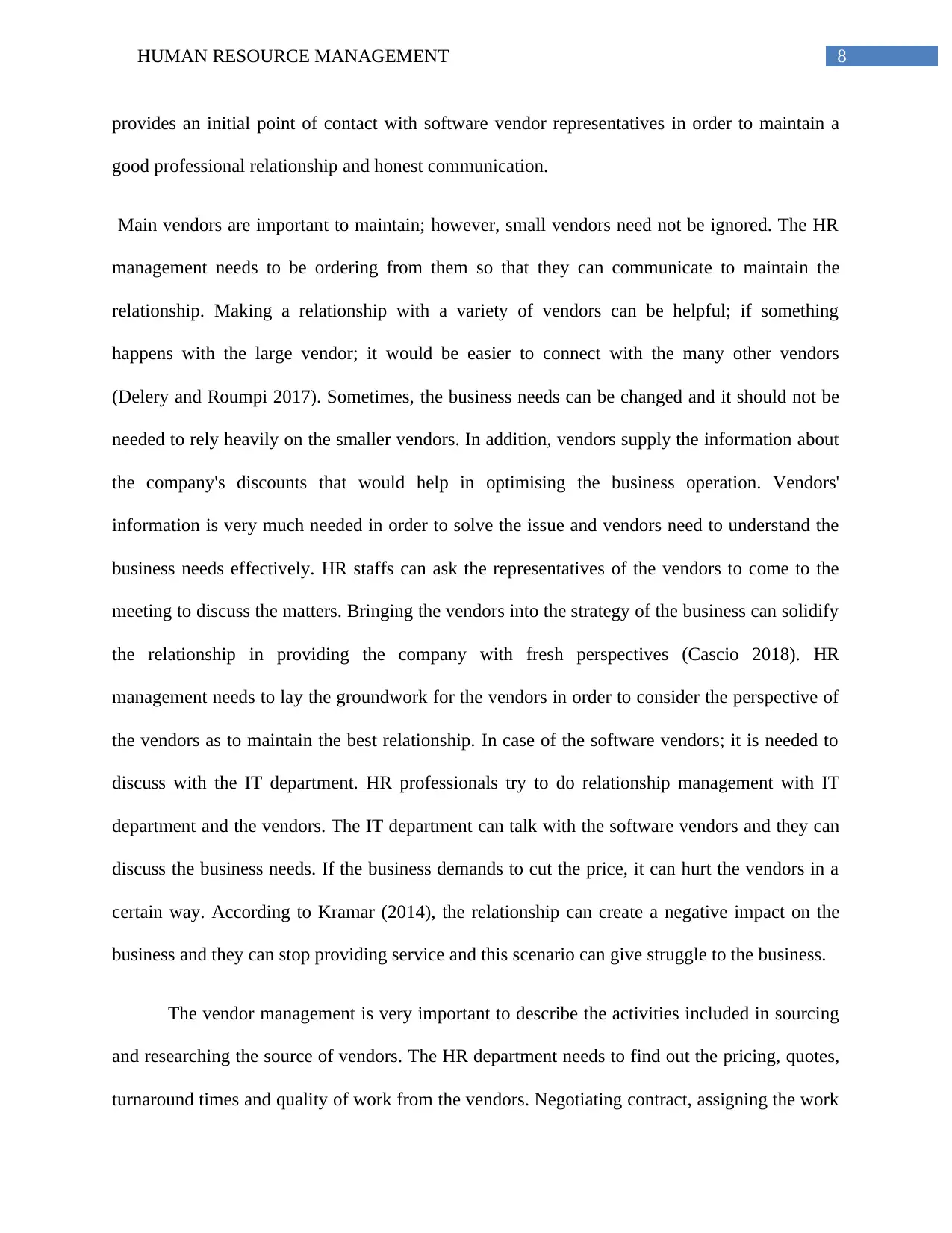
8HUMAN RESOURCE MANAGEMENT
provides an initial point of contact with software vendor representatives in order to maintain a
good professional relationship and honest communication.
Main vendors are important to maintain; however, small vendors need not be ignored. The HR
management needs to be ordering from them so that they can communicate to maintain the
relationship. Making a relationship with a variety of vendors can be helpful; if something
happens with the large vendor; it would be easier to connect with the many other vendors
(Delery and Roumpi 2017). Sometimes, the business needs can be changed and it should not be
needed to rely heavily on the smaller vendors. In addition, vendors supply the information about
the company's discounts that would help in optimising the business operation. Vendors'
information is very much needed in order to solve the issue and vendors need to understand the
business needs effectively. HR staffs can ask the representatives of the vendors to come to the
meeting to discuss the matters. Bringing the vendors into the strategy of the business can solidify
the relationship in providing the company with fresh perspectives (Cascio 2018). HR
management needs to lay the groundwork for the vendors in order to consider the perspective of
the vendors as to maintain the best relationship. In case of the software vendors; it is needed to
discuss with the IT department. HR professionals try to do relationship management with IT
department and the vendors. The IT department can talk with the software vendors and they can
discuss the business needs. If the business demands to cut the price, it can hurt the vendors in a
certain way. According to Kramar (2014), the relationship can create a negative impact on the
business and they can stop providing service and this scenario can give struggle to the business.
The vendor management is very important to describe the activities included in sourcing
and researching the source of vendors. The HR department needs to find out the pricing, quotes,
turnaround times and quality of work from the vendors. Negotiating contract, assigning the work
provides an initial point of contact with software vendor representatives in order to maintain a
good professional relationship and honest communication.
Main vendors are important to maintain; however, small vendors need not be ignored. The HR
management needs to be ordering from them so that they can communicate to maintain the
relationship. Making a relationship with a variety of vendors can be helpful; if something
happens with the large vendor; it would be easier to connect with the many other vendors
(Delery and Roumpi 2017). Sometimes, the business needs can be changed and it should not be
needed to rely heavily on the smaller vendors. In addition, vendors supply the information about
the company's discounts that would help in optimising the business operation. Vendors'
information is very much needed in order to solve the issue and vendors need to understand the
business needs effectively. HR staffs can ask the representatives of the vendors to come to the
meeting to discuss the matters. Bringing the vendors into the strategy of the business can solidify
the relationship in providing the company with fresh perspectives (Cascio 2018). HR
management needs to lay the groundwork for the vendors in order to consider the perspective of
the vendors as to maintain the best relationship. In case of the software vendors; it is needed to
discuss with the IT department. HR professionals try to do relationship management with IT
department and the vendors. The IT department can talk with the software vendors and they can
discuss the business needs. If the business demands to cut the price, it can hurt the vendors in a
certain way. According to Kramar (2014), the relationship can create a negative impact on the
business and they can stop providing service and this scenario can give struggle to the business.
The vendor management is very important to describe the activities included in sourcing
and researching the source of vendors. The HR department needs to find out the pricing, quotes,
turnaround times and quality of work from the vendors. Negotiating contract, assigning the work
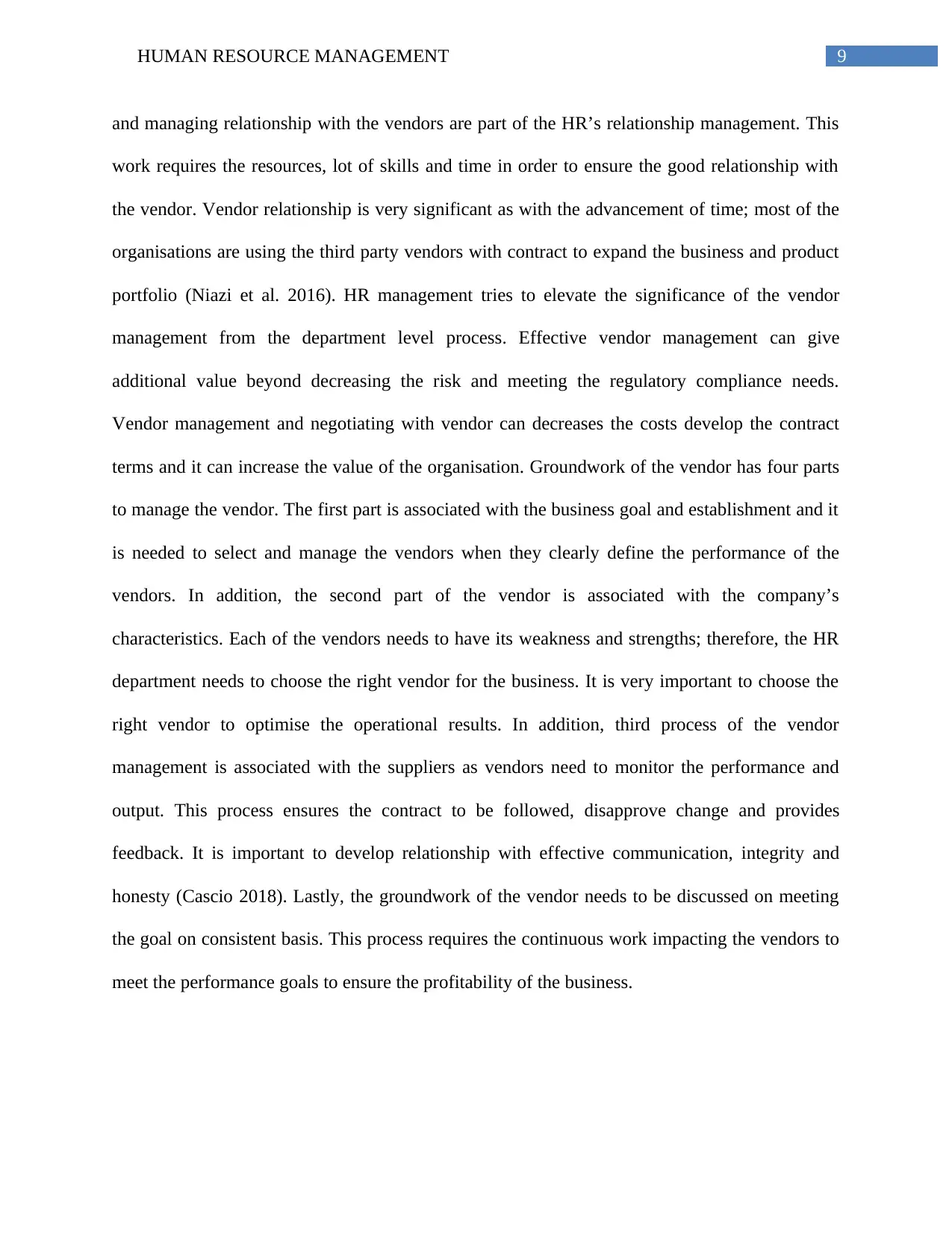
9HUMAN RESOURCE MANAGEMENT
and managing relationship with the vendors are part of the HR’s relationship management. This
work requires the resources, lot of skills and time in order to ensure the good relationship with
the vendor. Vendor relationship is very significant as with the advancement of time; most of the
organisations are using the third party vendors with contract to expand the business and product
portfolio (Niazi et al. 2016). HR management tries to elevate the significance of the vendor
management from the department level process. Effective vendor management can give
additional value beyond decreasing the risk and meeting the regulatory compliance needs.
Vendor management and negotiating with vendor can decreases the costs develop the contract
terms and it can increase the value of the organisation. Groundwork of the vendor has four parts
to manage the vendor. The first part is associated with the business goal and establishment and it
is needed to select and manage the vendors when they clearly define the performance of the
vendors. In addition, the second part of the vendor is associated with the company’s
characteristics. Each of the vendors needs to have its weakness and strengths; therefore, the HR
department needs to choose the right vendor for the business. It is very important to choose the
right vendor to optimise the operational results. In addition, third process of the vendor
management is associated with the suppliers as vendors need to monitor the performance and
output. This process ensures the contract to be followed, disapprove change and provides
feedback. It is important to develop relationship with effective communication, integrity and
honesty (Cascio 2018). Lastly, the groundwork of the vendor needs to be discussed on meeting
the goal on consistent basis. This process requires the continuous work impacting the vendors to
meet the performance goals to ensure the profitability of the business.
and managing relationship with the vendors are part of the HR’s relationship management. This
work requires the resources, lot of skills and time in order to ensure the good relationship with
the vendor. Vendor relationship is very significant as with the advancement of time; most of the
organisations are using the third party vendors with contract to expand the business and product
portfolio (Niazi et al. 2016). HR management tries to elevate the significance of the vendor
management from the department level process. Effective vendor management can give
additional value beyond decreasing the risk and meeting the regulatory compliance needs.
Vendor management and negotiating with vendor can decreases the costs develop the contract
terms and it can increase the value of the organisation. Groundwork of the vendor has four parts
to manage the vendor. The first part is associated with the business goal and establishment and it
is needed to select and manage the vendors when they clearly define the performance of the
vendors. In addition, the second part of the vendor is associated with the company’s
characteristics. Each of the vendors needs to have its weakness and strengths; therefore, the HR
department needs to choose the right vendor for the business. It is very important to choose the
right vendor to optimise the operational results. In addition, third process of the vendor
management is associated with the suppliers as vendors need to monitor the performance and
output. This process ensures the contract to be followed, disapprove change and provides
feedback. It is important to develop relationship with effective communication, integrity and
honesty (Cascio 2018). Lastly, the groundwork of the vendor needs to be discussed on meeting
the goal on consistent basis. This process requires the continuous work impacting the vendors to
meet the performance goals to ensure the profitability of the business.
Paraphrase This Document
Need a fresh take? Get an instant paraphrase of this document with our AI Paraphraser
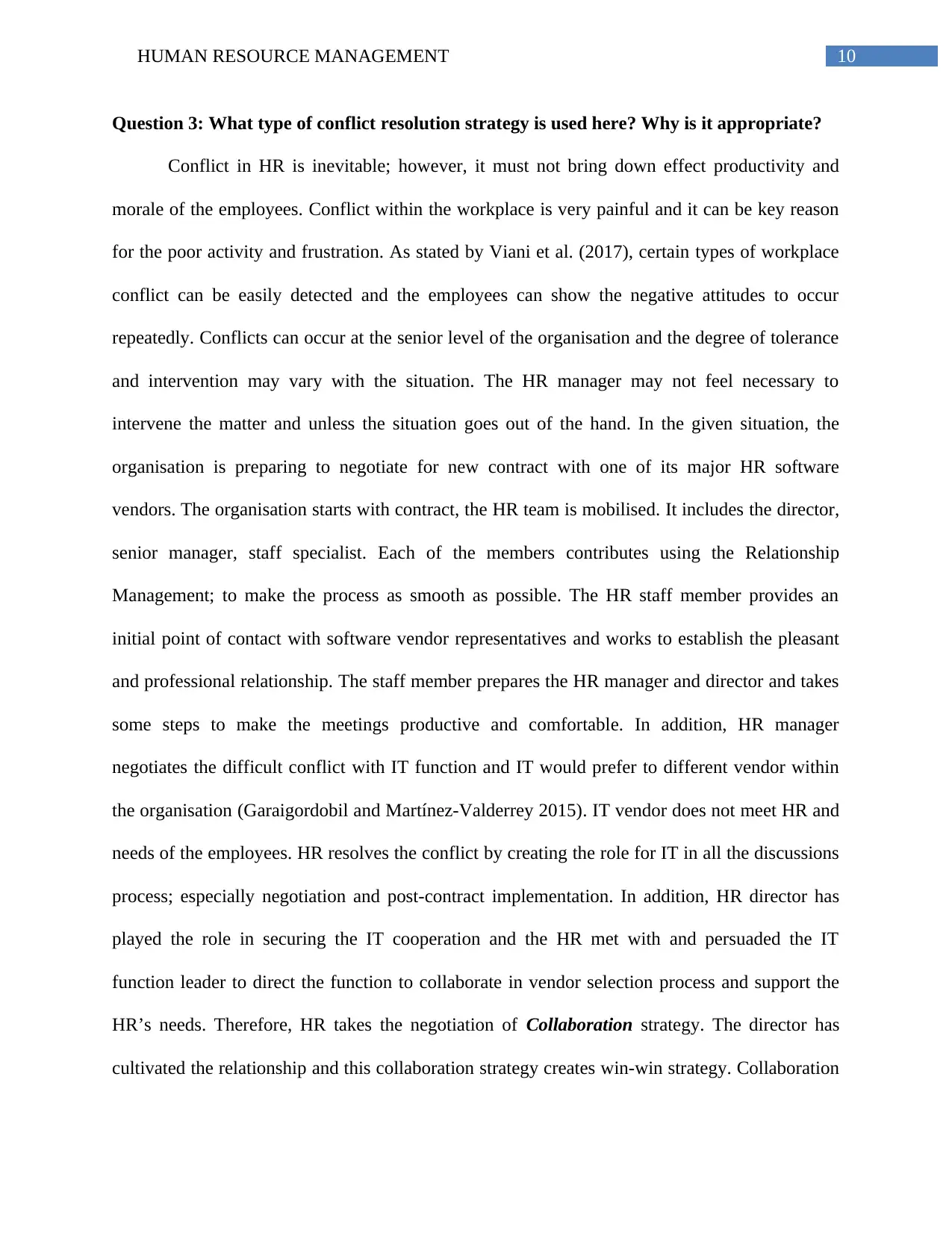
10HUMAN RESOURCE MANAGEMENT
Question 3: What type of conflict resolution strategy is used here? Why is it appropriate?
Conflict in HR is inevitable; however, it must not bring down effect productivity and
morale of the employees. Conflict within the workplace is very painful and it can be key reason
for the poor activity and frustration. As stated by Viani et al. (2017), certain types of workplace
conflict can be easily detected and the employees can show the negative attitudes to occur
repeatedly. Conflicts can occur at the senior level of the organisation and the degree of tolerance
and intervention may vary with the situation. The HR manager may not feel necessary to
intervene the matter and unless the situation goes out of the hand. In the given situation, the
organisation is preparing to negotiate for new contract with one of its major HR software
vendors. The organisation starts with contract, the HR team is mobilised. It includes the director,
senior manager, staff specialist. Each of the members contributes using the Relationship
Management; to make the process as smooth as possible. The HR staff member provides an
initial point of contact with software vendor representatives and works to establish the pleasant
and professional relationship. The staff member prepares the HR manager and director and takes
some steps to make the meetings productive and comfortable. In addition, HR manager
negotiates the difficult conflict with IT function and IT would prefer to different vendor within
the organisation (Garaigordobil and Martínez-Valderrey 2015). IT vendor does not meet HR and
needs of the employees. HR resolves the conflict by creating the role for IT in all the discussions
process; especially negotiation and post-contract implementation. In addition, HR director has
played the role in securing the IT cooperation and the HR met with and persuaded the IT
function leader to direct the function to collaborate in vendor selection process and support the
HR’s needs. Therefore, HR takes the negotiation of Collaboration strategy. The director has
cultivated the relationship and this collaboration strategy creates win-win strategy. Collaboration
Question 3: What type of conflict resolution strategy is used here? Why is it appropriate?
Conflict in HR is inevitable; however, it must not bring down effect productivity and
morale of the employees. Conflict within the workplace is very painful and it can be key reason
for the poor activity and frustration. As stated by Viani et al. (2017), certain types of workplace
conflict can be easily detected and the employees can show the negative attitudes to occur
repeatedly. Conflicts can occur at the senior level of the organisation and the degree of tolerance
and intervention may vary with the situation. The HR manager may not feel necessary to
intervene the matter and unless the situation goes out of the hand. In the given situation, the
organisation is preparing to negotiate for new contract with one of its major HR software
vendors. The organisation starts with contract, the HR team is mobilised. It includes the director,
senior manager, staff specialist. Each of the members contributes using the Relationship
Management; to make the process as smooth as possible. The HR staff member provides an
initial point of contact with software vendor representatives and works to establish the pleasant
and professional relationship. The staff member prepares the HR manager and director and takes
some steps to make the meetings productive and comfortable. In addition, HR manager
negotiates the difficult conflict with IT function and IT would prefer to different vendor within
the organisation (Garaigordobil and Martínez-Valderrey 2015). IT vendor does not meet HR and
needs of the employees. HR resolves the conflict by creating the role for IT in all the discussions
process; especially negotiation and post-contract implementation. In addition, HR director has
played the role in securing the IT cooperation and the HR met with and persuaded the IT
function leader to direct the function to collaborate in vendor selection process and support the
HR’s needs. Therefore, HR takes the negotiation of Collaboration strategy. The director has
cultivated the relationship and this collaboration strategy creates win-win strategy. Collaboration
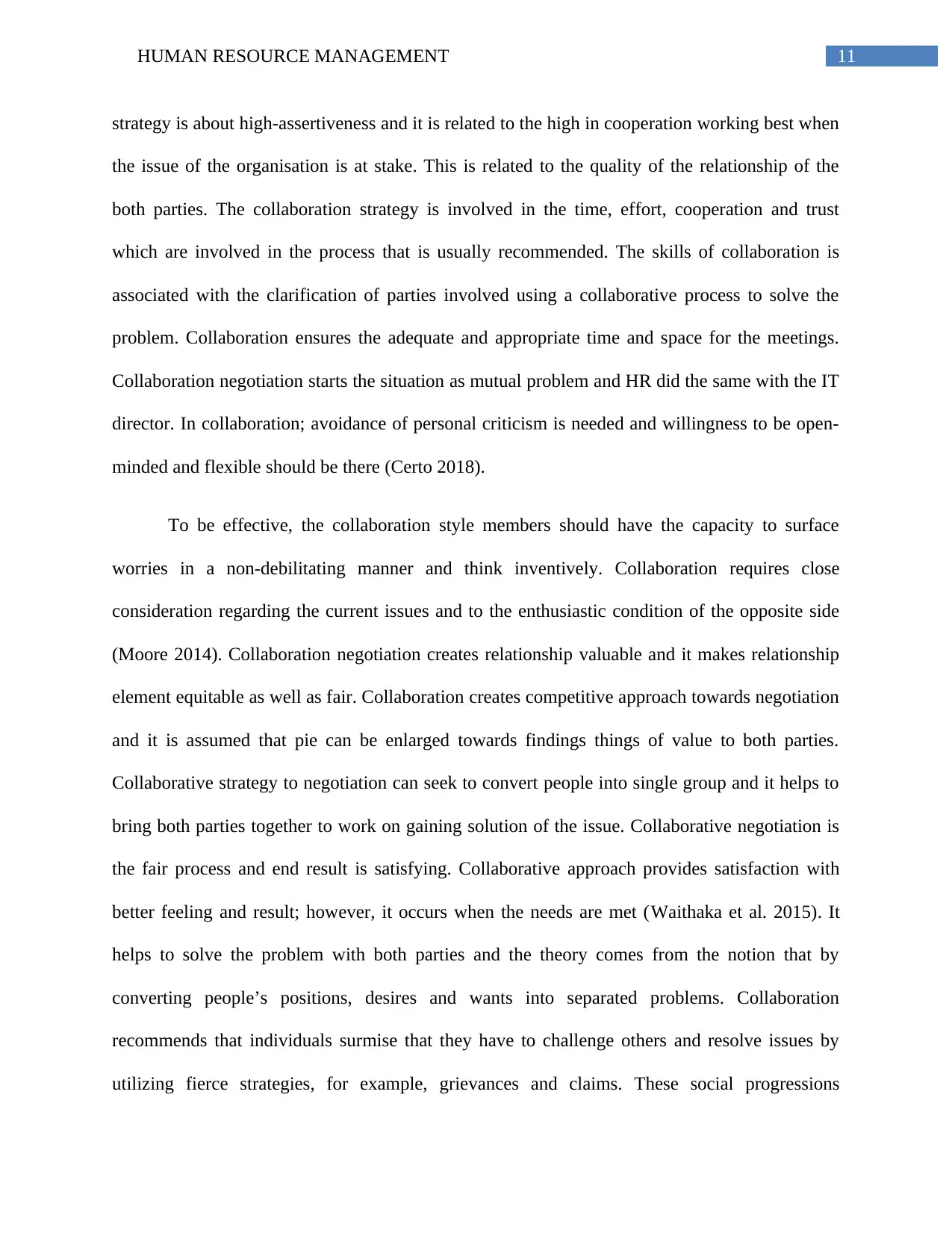
11HUMAN RESOURCE MANAGEMENT
strategy is about high-assertiveness and it is related to the high in cooperation working best when
the issue of the organisation is at stake. This is related to the quality of the relationship of the
both parties. The collaboration strategy is involved in the time, effort, cooperation and trust
which are involved in the process that is usually recommended. The skills of collaboration is
associated with the clarification of parties involved using a collaborative process to solve the
problem. Collaboration ensures the adequate and appropriate time and space for the meetings.
Collaboration negotiation starts the situation as mutual problem and HR did the same with the IT
director. In collaboration; avoidance of personal criticism is needed and willingness to be open-
minded and flexible should be there (Certo 2018).
To be effective, the collaboration style members should have the capacity to surface
worries in a non-debilitating manner and think inventively. Collaboration requires close
consideration regarding the current issues and to the enthusiastic condition of the opposite side
(Moore 2014). Collaboration negotiation creates relationship valuable and it makes relationship
element equitable as well as fair. Collaboration creates competitive approach towards negotiation
and it is assumed that pie can be enlarged towards findings things of value to both parties.
Collaborative strategy to negotiation can seek to convert people into single group and it helps to
bring both parties together to work on gaining solution of the issue. Collaborative negotiation is
the fair process and end result is satisfying. Collaborative approach provides satisfaction with
better feeling and result; however, it occurs when the needs are met (Waithaka et al. 2015). It
helps to solve the problem with both parties and the theory comes from the notion that by
converting people’s positions, desires and wants into separated problems. Collaboration
recommends that individuals surmise that they have to challenge others and resolve issues by
utilizing fierce strategies, for example, grievances and claims. These social progressions
strategy is about high-assertiveness and it is related to the high in cooperation working best when
the issue of the organisation is at stake. This is related to the quality of the relationship of the
both parties. The collaboration strategy is involved in the time, effort, cooperation and trust
which are involved in the process that is usually recommended. The skills of collaboration is
associated with the clarification of parties involved using a collaborative process to solve the
problem. Collaboration ensures the adequate and appropriate time and space for the meetings.
Collaboration negotiation starts the situation as mutual problem and HR did the same with the IT
director. In collaboration; avoidance of personal criticism is needed and willingness to be open-
minded and flexible should be there (Certo 2018).
To be effective, the collaboration style members should have the capacity to surface
worries in a non-debilitating manner and think inventively. Collaboration requires close
consideration regarding the current issues and to the enthusiastic condition of the opposite side
(Moore 2014). Collaboration negotiation creates relationship valuable and it makes relationship
element equitable as well as fair. Collaboration creates competitive approach towards negotiation
and it is assumed that pie can be enlarged towards findings things of value to both parties.
Collaborative strategy to negotiation can seek to convert people into single group and it helps to
bring both parties together to work on gaining solution of the issue. Collaborative negotiation is
the fair process and end result is satisfying. Collaborative approach provides satisfaction with
better feeling and result; however, it occurs when the needs are met (Waithaka et al. 2015). It
helps to solve the problem with both parties and the theory comes from the notion that by
converting people’s positions, desires and wants into separated problems. Collaboration
recommends that individuals surmise that they have to challenge others and resolve issues by
utilizing fierce strategies, for example, grievances and claims. These social progressions
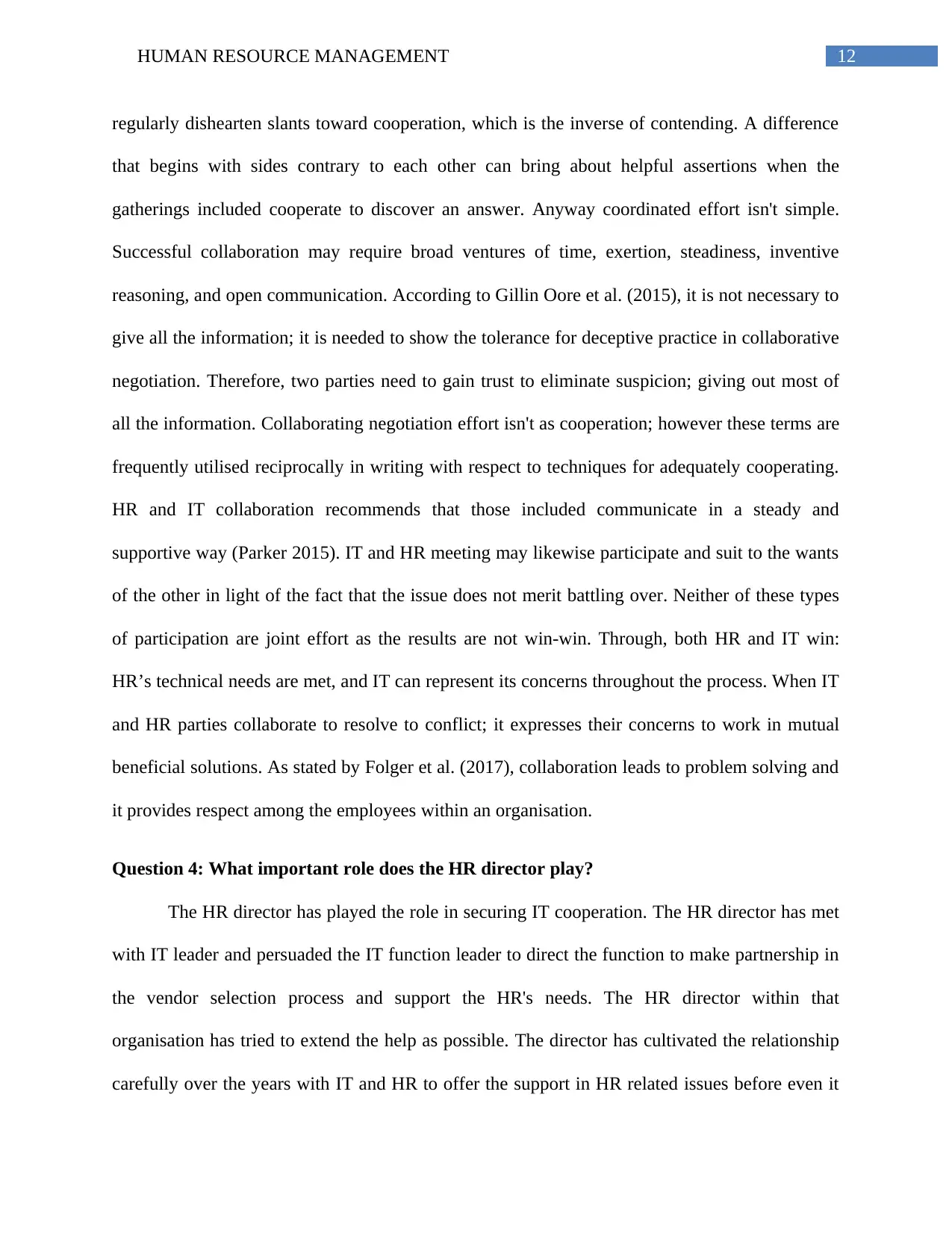
12HUMAN RESOURCE MANAGEMENT
regularly dishearten slants toward cooperation, which is the inverse of contending. A difference
that begins with sides contrary to each other can bring about helpful assertions when the
gatherings included cooperate to discover an answer. Anyway coordinated effort isn't simple.
Successful collaboration may require broad ventures of time, exertion, steadiness, inventive
reasoning, and open communication. According to Gillin Oore et al. (2015), it is not necessary to
give all the information; it is needed to show the tolerance for deceptive practice in collaborative
negotiation. Therefore, two parties need to gain trust to eliminate suspicion; giving out most of
all the information. Collaborating negotiation effort isn't as cooperation; however these terms are
frequently utilised reciprocally in writing with respect to techniques for adequately cooperating.
HR and IT collaboration recommends that those included communicate in a steady and
supportive way (Parker 2015). IT and HR meeting may likewise participate and suit to the wants
of the other in light of the fact that the issue does not merit battling over. Neither of these types
of participation are joint effort as the results are not win-win. Through, both HR and IT win:
HR’s technical needs are met, and IT can represent its concerns throughout the process. When IT
and HR parties collaborate to resolve to conflict; it expresses their concerns to work in mutual
beneficial solutions. As stated by Folger et al. (2017), collaboration leads to problem solving and
it provides respect among the employees within an organisation.
Question 4: What important role does the HR director play?
The HR director has played the role in securing IT cooperation. The HR director has met
with IT leader and persuaded the IT function leader to direct the function to make partnership in
the vendor selection process and support the HR's needs. The HR director within that
organisation has tried to extend the help as possible. The director has cultivated the relationship
carefully over the years with IT and HR to offer the support in HR related issues before even it
regularly dishearten slants toward cooperation, which is the inverse of contending. A difference
that begins with sides contrary to each other can bring about helpful assertions when the
gatherings included cooperate to discover an answer. Anyway coordinated effort isn't simple.
Successful collaboration may require broad ventures of time, exertion, steadiness, inventive
reasoning, and open communication. According to Gillin Oore et al. (2015), it is not necessary to
give all the information; it is needed to show the tolerance for deceptive practice in collaborative
negotiation. Therefore, two parties need to gain trust to eliminate suspicion; giving out most of
all the information. Collaborating negotiation effort isn't as cooperation; however these terms are
frequently utilised reciprocally in writing with respect to techniques for adequately cooperating.
HR and IT collaboration recommends that those included communicate in a steady and
supportive way (Parker 2015). IT and HR meeting may likewise participate and suit to the wants
of the other in light of the fact that the issue does not merit battling over. Neither of these types
of participation are joint effort as the results are not win-win. Through, both HR and IT win:
HR’s technical needs are met, and IT can represent its concerns throughout the process. When IT
and HR parties collaborate to resolve to conflict; it expresses their concerns to work in mutual
beneficial solutions. As stated by Folger et al. (2017), collaboration leads to problem solving and
it provides respect among the employees within an organisation.
Question 4: What important role does the HR director play?
The HR director has played the role in securing IT cooperation. The HR director has met
with IT leader and persuaded the IT function leader to direct the function to make partnership in
the vendor selection process and support the HR's needs. The HR director within that
organisation has tried to extend the help as possible. The director has cultivated the relationship
carefully over the years with IT and HR to offer the support in HR related issues before even it
Secure Best Marks with AI Grader
Need help grading? Try our AI Grader for instant feedback on your assignments.
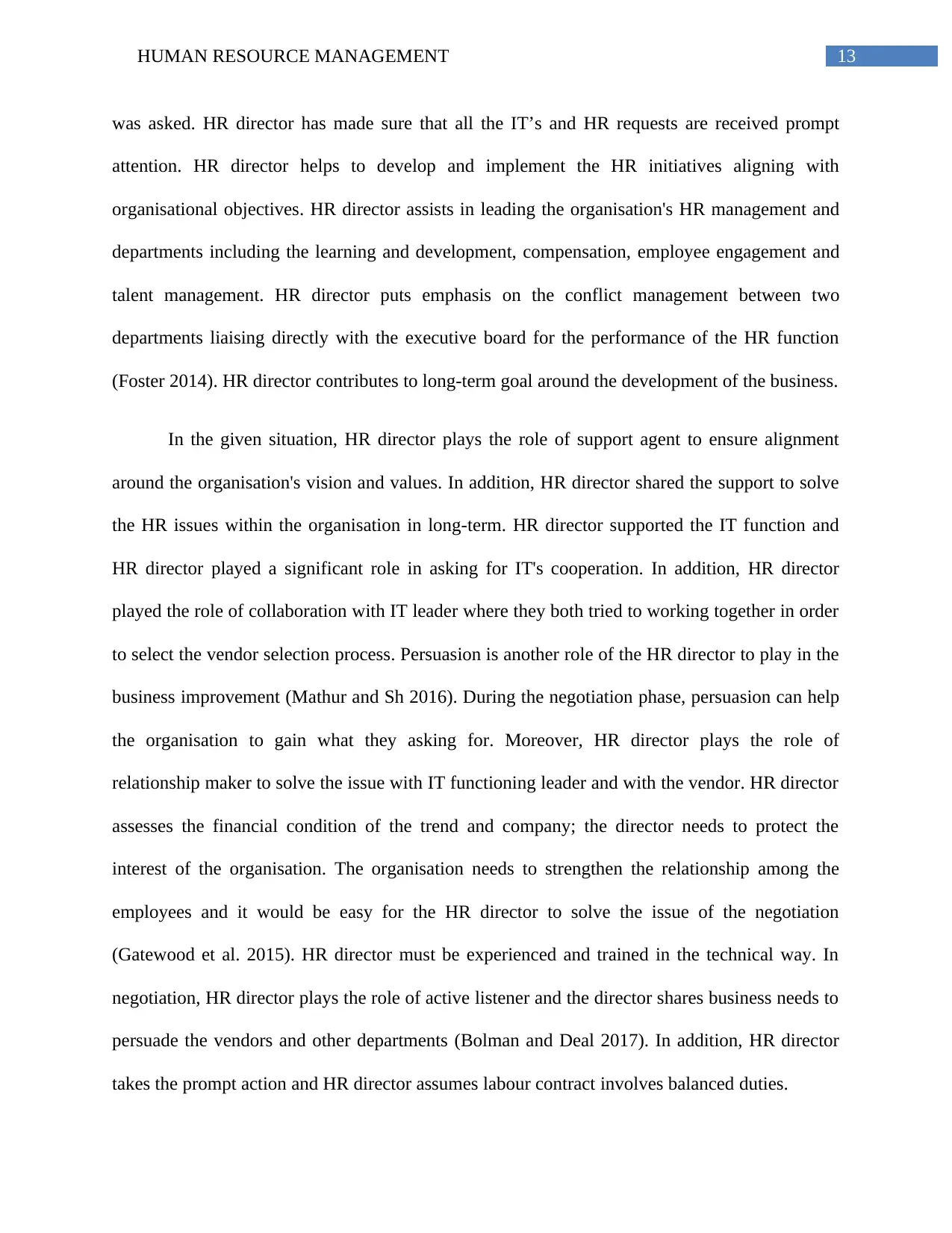
13HUMAN RESOURCE MANAGEMENT
was asked. HR director has made sure that all the IT’s and HR requests are received prompt
attention. HR director helps to develop and implement the HR initiatives aligning with
organisational objectives. HR director assists in leading the organisation's HR management and
departments including the learning and development, compensation, employee engagement and
talent management. HR director puts emphasis on the conflict management between two
departments liaising directly with the executive board for the performance of the HR function
(Foster 2014). HR director contributes to long-term goal around the development of the business.
In the given situation, HR director plays the role of support agent to ensure alignment
around the organisation's vision and values. In addition, HR director shared the support to solve
the HR issues within the organisation in long-term. HR director supported the IT function and
HR director played a significant role in asking for IT's cooperation. In addition, HR director
played the role of collaboration with IT leader where they both tried to working together in order
to select the vendor selection process. Persuasion is another role of the HR director to play in the
business improvement (Mathur and Sh 2016). During the negotiation phase, persuasion can help
the organisation to gain what they asking for. Moreover, HR director plays the role of
relationship maker to solve the issue with IT functioning leader and with the vendor. HR director
assesses the financial condition of the trend and company; the director needs to protect the
interest of the organisation. The organisation needs to strengthen the relationship among the
employees and it would be easy for the HR director to solve the issue of the negotiation
(Gatewood et al. 2015). HR director must be experienced and trained in the technical way. In
negotiation, HR director plays the role of active listener and the director shares business needs to
persuade the vendors and other departments (Bolman and Deal 2017). In addition, HR director
takes the prompt action and HR director assumes labour contract involves balanced duties.
was asked. HR director has made sure that all the IT’s and HR requests are received prompt
attention. HR director helps to develop and implement the HR initiatives aligning with
organisational objectives. HR director assists in leading the organisation's HR management and
departments including the learning and development, compensation, employee engagement and
talent management. HR director puts emphasis on the conflict management between two
departments liaising directly with the executive board for the performance of the HR function
(Foster 2014). HR director contributes to long-term goal around the development of the business.
In the given situation, HR director plays the role of support agent to ensure alignment
around the organisation's vision and values. In addition, HR director shared the support to solve
the HR issues within the organisation in long-term. HR director supported the IT function and
HR director played a significant role in asking for IT's cooperation. In addition, HR director
played the role of collaboration with IT leader where they both tried to working together in order
to select the vendor selection process. Persuasion is another role of the HR director to play in the
business improvement (Mathur and Sh 2016). During the negotiation phase, persuasion can help
the organisation to gain what they asking for. Moreover, HR director plays the role of
relationship maker to solve the issue with IT functioning leader and with the vendor. HR director
assesses the financial condition of the trend and company; the director needs to protect the
interest of the organisation. The organisation needs to strengthen the relationship among the
employees and it would be easy for the HR director to solve the issue of the negotiation
(Gatewood et al. 2015). HR director must be experienced and trained in the technical way. In
negotiation, HR director plays the role of active listener and the director shares business needs to
persuade the vendors and other departments (Bolman and Deal 2017). In addition, HR director
takes the prompt action and HR director assumes labour contract involves balanced duties.

14HUMAN RESOURCE MANAGEMENT
Negotiation itself has a tendency to have an image issue. Actually, regardless of whether
employees in the private or people in general segment, employees will go into various levels of
transaction consistently. There are transactions with providers, for example, enlistment
organisations or preparing suppliers, and contrasts of supposition between line supervisors and
staff. Notwithstanding something as basic as working out the occasion rota is an essential type of
negotiation. Transactions can end up enthusiastic, especially in discourses around repetition or
pay. Warner prompts the most ideal approach to manage this is to stay cool and not ascend to
any affront, dismissing the addressing if require be until everybody has quieted down. While
negotiations are second nature to all the more business capacities, particularly on value, HR
experts may not feel as good requesting that others bargain (Wallensteen 2015). In any case, the
ascent in outsourcing connections or manages outside providers implies that there is a more
noteworthy than at any other time need to beat the dread that proposition will be rejected.
Question 5: What other Behavioural Competencies do you see being used?
Within an organisation, HR department needs to play different types of roles and
behavioural competency attributes of the HR manager and HR director contributes the
development of the organisation to take the bigger role in assigning the behaviour competency.
Behaviour attributes of HR department can be teamwork, leadership skill, skill set, knowledge
and technical know-how.
Communication: In the given situation, HR manager resolved the conflict by
establishing the role of IT in all situations. HR manager wanted to discuss each matter with IT
functioning leader and the HR managers knew the importance of communication in an
organisation. Especially in the case of negotiation and post-contract implementation of the
vendor; communication is very important. As opined by Ebeling et al. (2014), HR manager
Negotiation itself has a tendency to have an image issue. Actually, regardless of whether
employees in the private or people in general segment, employees will go into various levels of
transaction consistently. There are transactions with providers, for example, enlistment
organisations or preparing suppliers, and contrasts of supposition between line supervisors and
staff. Notwithstanding something as basic as working out the occasion rota is an essential type of
negotiation. Transactions can end up enthusiastic, especially in discourses around repetition or
pay. Warner prompts the most ideal approach to manage this is to stay cool and not ascend to
any affront, dismissing the addressing if require be until everybody has quieted down. While
negotiations are second nature to all the more business capacities, particularly on value, HR
experts may not feel as good requesting that others bargain (Wallensteen 2015). In any case, the
ascent in outsourcing connections or manages outside providers implies that there is a more
noteworthy than at any other time need to beat the dread that proposition will be rejected.
Question 5: What other Behavioural Competencies do you see being used?
Within an organisation, HR department needs to play different types of roles and
behavioural competency attributes of the HR manager and HR director contributes the
development of the organisation to take the bigger role in assigning the behaviour competency.
Behaviour attributes of HR department can be teamwork, leadership skill, skill set, knowledge
and technical know-how.
Communication: In the given situation, HR manager resolved the conflict by
establishing the role of IT in all situations. HR manager wanted to discuss each matter with IT
functioning leader and the HR managers knew the importance of communication in an
organisation. Especially in the case of negotiation and post-contract implementation of the
vendor; communication is very important. As opined by Ebeling et al. (2014), HR manager

15HUMAN RESOURCE MANAGEMENT
needs to be able to communicate with each one in the workplace. HR manager and HR director
should have the skill of communication so that they can communicate with all with providing
outsourcing and knowledge to the public officials, union leaders and employees. The HR
manager and HR director have the capability to adapt the communication skill to the audience
and the situation.
Critical thinking and analytical skill: HR manager played the role of analytical
thinking skill when the manager asked the IT functioning leader to join the discussion about
vendor although IT's vendor does not match the requirement. In addition, HR manager and HR
director have the capability of sound judgement so that their decision-making must be high-
impact on the business. In order to negotiate the matter, the ability to analyse the matter is very
important and in this case, critical thinking skill is very important. HR staffs also have the
behavioural competency of critical thinking skill to represent the company when it is needed.
The HR staffs sometimes need to provide justification of the employment decision; in this
scenario; the analytical capability is needed. In the given situation, the staff member prepares the
HR manager and director and take the steps to make the meetings comfortable and productive in
the own credit; this does not possible without having analytical skill.
Empathy: HR director showed the behavioural competency of empathy towards the IT
department and the employees. Being able to perceive the feeling of the people when the people
do not express the same in verbally is called empathy (Grobler and Du Plessis 2016). Words can
convey a feeling; however many of the non-verbal clues can deliver the empathy to the people.
HR director showed her empathy through the cooperation and her persuasion process. Without
empathy, HR director could not direct the function to partnership the vendor selection process
and support the desires of the HR. In the meetings with the vendor and IT leader, the HR director
needs to be able to communicate with each one in the workplace. HR manager and HR director
should have the skill of communication so that they can communicate with all with providing
outsourcing and knowledge to the public officials, union leaders and employees. The HR
manager and HR director have the capability to adapt the communication skill to the audience
and the situation.
Critical thinking and analytical skill: HR manager played the role of analytical
thinking skill when the manager asked the IT functioning leader to join the discussion about
vendor although IT's vendor does not match the requirement. In addition, HR manager and HR
director have the capability of sound judgement so that their decision-making must be high-
impact on the business. In order to negotiate the matter, the ability to analyse the matter is very
important and in this case, critical thinking skill is very important. HR staffs also have the
behavioural competency of critical thinking skill to represent the company when it is needed.
The HR staffs sometimes need to provide justification of the employment decision; in this
scenario; the analytical capability is needed. In the given situation, the staff member prepares the
HR manager and director and take the steps to make the meetings comfortable and productive in
the own credit; this does not possible without having analytical skill.
Empathy: HR director showed the behavioural competency of empathy towards the IT
department and the employees. Being able to perceive the feeling of the people when the people
do not express the same in verbally is called empathy (Grobler and Du Plessis 2016). Words can
convey a feeling; however many of the non-verbal clues can deliver the empathy to the people.
HR director showed her empathy through the cooperation and her persuasion process. Without
empathy, HR director could not direct the function to partnership the vendor selection process
and support the desires of the HR. In the meetings with the vendor and IT leader, the HR director
Paraphrase This Document
Need a fresh take? Get an instant paraphrase of this document with our AI Paraphraser
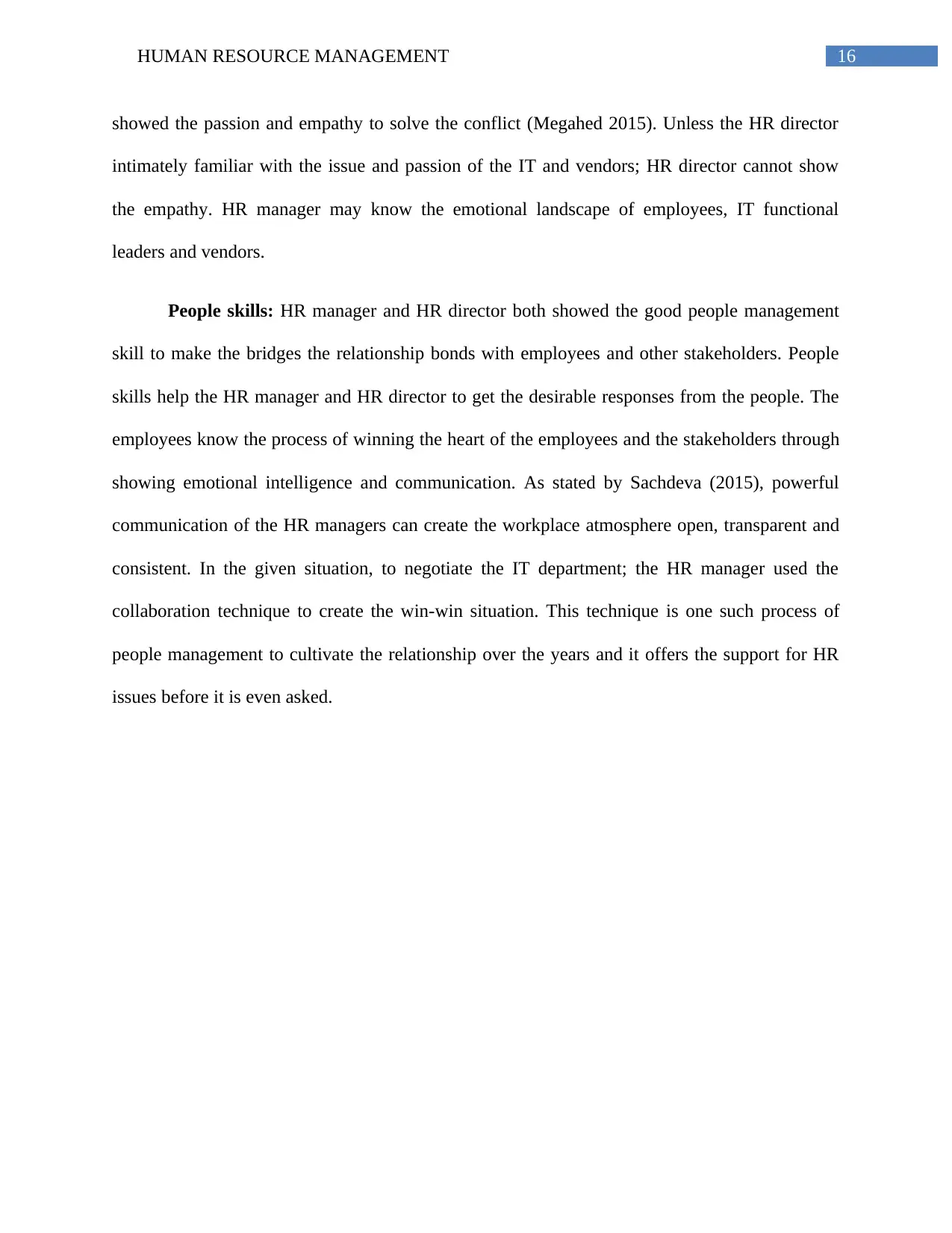
16HUMAN RESOURCE MANAGEMENT
showed the passion and empathy to solve the conflict (Megahed 2015). Unless the HR director
intimately familiar with the issue and passion of the IT and vendors; HR director cannot show
the empathy. HR manager may know the emotional landscape of employees, IT functional
leaders and vendors.
People skills: HR manager and HR director both showed the good people management
skill to make the bridges the relationship bonds with employees and other stakeholders. People
skills help the HR manager and HR director to get the desirable responses from the people. The
employees know the process of winning the heart of the employees and the stakeholders through
showing emotional intelligence and communication. As stated by Sachdeva (2015), powerful
communication of the HR managers can create the workplace atmosphere open, transparent and
consistent. In the given situation, to negotiate the IT department; the HR manager used the
collaboration technique to create the win-win situation. This technique is one such process of
people management to cultivate the relationship over the years and it offers the support for HR
issues before it is even asked.
showed the passion and empathy to solve the conflict (Megahed 2015). Unless the HR director
intimately familiar with the issue and passion of the IT and vendors; HR director cannot show
the empathy. HR manager may know the emotional landscape of employees, IT functional
leaders and vendors.
People skills: HR manager and HR director both showed the good people management
skill to make the bridges the relationship bonds with employees and other stakeholders. People
skills help the HR manager and HR director to get the desirable responses from the people. The
employees know the process of winning the heart of the employees and the stakeholders through
showing emotional intelligence and communication. As stated by Sachdeva (2015), powerful
communication of the HR managers can create the workplace atmosphere open, transparent and
consistent. In the given situation, to negotiate the IT department; the HR manager used the
collaboration technique to create the win-win situation. This technique is one such process of
people management to cultivate the relationship over the years and it offers the support for HR
issues before it is even asked.
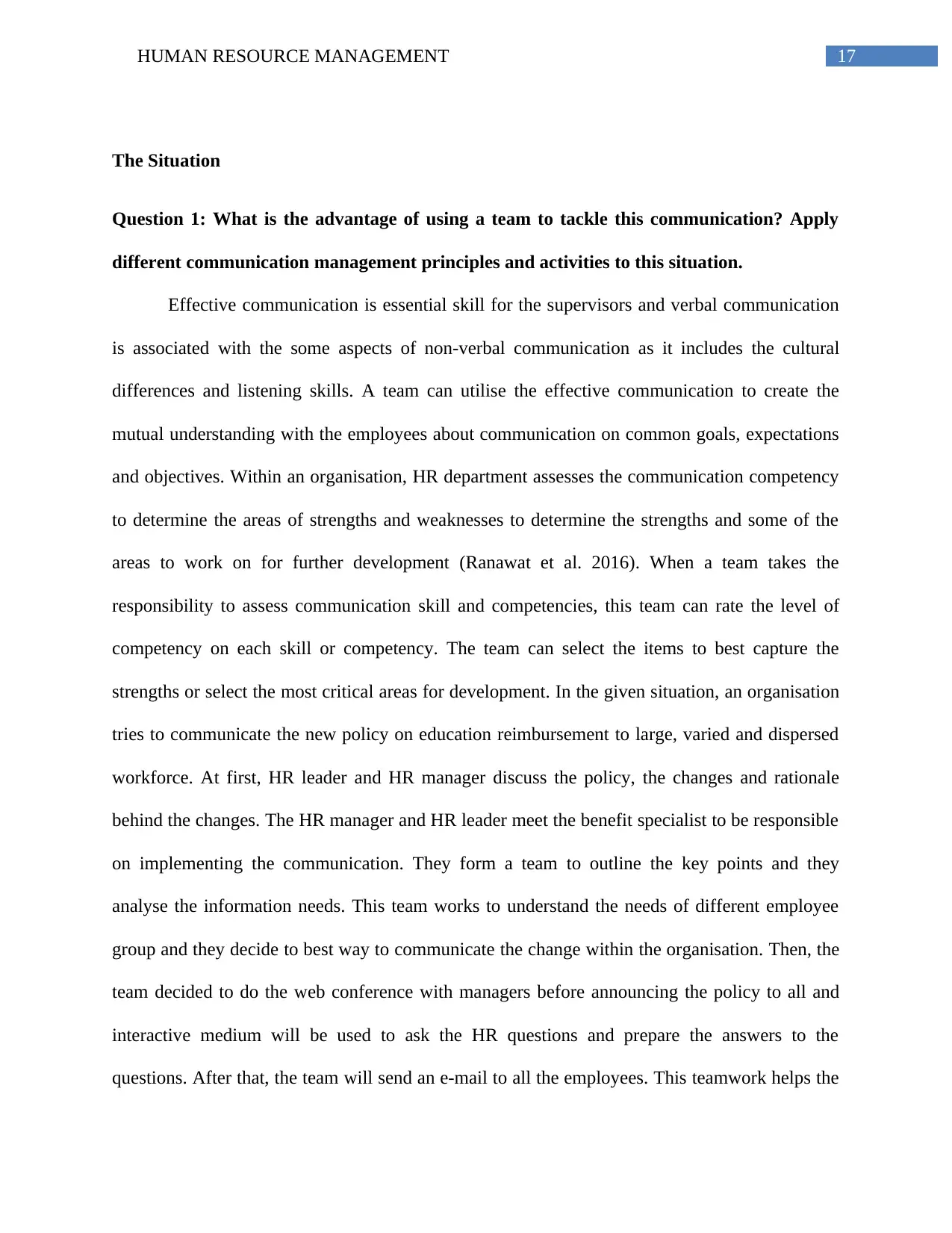
17HUMAN RESOURCE MANAGEMENT
The Situation
Question 1: What is the advantage of using a team to tackle this communication? Apply
different communication management principles and activities to this situation.
Effective communication is essential skill for the supervisors and verbal communication
is associated with the some aspects of non-verbal communication as it includes the cultural
differences and listening skills. A team can utilise the effective communication to create the
mutual understanding with the employees about communication on common goals, expectations
and objectives. Within an organisation, HR department assesses the communication competency
to determine the areas of strengths and weaknesses to determine the strengths and some of the
areas to work on for further development (Ranawat et al. 2016). When a team takes the
responsibility to assess communication skill and competencies, this team can rate the level of
competency on each skill or competency. The team can select the items to best capture the
strengths or select the most critical areas for development. In the given situation, an organisation
tries to communicate the new policy on education reimbursement to large, varied and dispersed
workforce. At first, HR leader and HR manager discuss the policy, the changes and rationale
behind the changes. The HR manager and HR leader meet the benefit specialist to be responsible
on implementing the communication. They form a team to outline the key points and they
analyse the information needs. This team works to understand the needs of different employee
group and they decide to best way to communicate the change within the organisation. Then, the
team decided to do the web conference with managers before announcing the policy to all and
interactive medium will be used to ask the HR questions and prepare the answers to the
questions. After that, the team will send an e-mail to all the employees. This teamwork helps the
The Situation
Question 1: What is the advantage of using a team to tackle this communication? Apply
different communication management principles and activities to this situation.
Effective communication is essential skill for the supervisors and verbal communication
is associated with the some aspects of non-verbal communication as it includes the cultural
differences and listening skills. A team can utilise the effective communication to create the
mutual understanding with the employees about communication on common goals, expectations
and objectives. Within an organisation, HR department assesses the communication competency
to determine the areas of strengths and weaknesses to determine the strengths and some of the
areas to work on for further development (Ranawat et al. 2016). When a team takes the
responsibility to assess communication skill and competencies, this team can rate the level of
competency on each skill or competency. The team can select the items to best capture the
strengths or select the most critical areas for development. In the given situation, an organisation
tries to communicate the new policy on education reimbursement to large, varied and dispersed
workforce. At first, HR leader and HR manager discuss the policy, the changes and rationale
behind the changes. The HR manager and HR leader meet the benefit specialist to be responsible
on implementing the communication. They form a team to outline the key points and they
analyse the information needs. This team works to understand the needs of different employee
group and they decide to best way to communicate the change within the organisation. Then, the
team decided to do the web conference with managers before announcing the policy to all and
interactive medium will be used to ask the HR questions and prepare the answers to the
questions. After that, the team will send an e-mail to all the employees. This teamwork helps the

18HUMAN RESOURCE MANAGEMENT
HR department to blend the complementary strength as working together always lets the
employees build the talent and understand the needs of the teammates. The team gets to
understand the strengths of the teammates as one team member may be good at creative thinking
and other team member may be good at critical thinking process. Working as a team in order to
build up the communication building up the trust as team working establishes the strong
relationship with co-workers (Karanges et al. 2015). Team working provides the benefits of open
communication and it will bring safety to allow the idea to encourage others. In addition, as
stated by Cardon (2014), sharing communication through a team can teach about the conflict
resolution skill and it would put together the group of unique people. In addition, employees
within an organisation come from varied background and communicating through a team can
help to share the viewpoints to create most successful work to generate the resentment.
Moreover, communication sharing through team can provide the benefit of tackling the obstacles
and it will help to create the notable work toward achieving the company goals.
Communication management is the planning process that occurs in systematic way of
implementing, revision and monitoring the process of communication. The process of
communication management can be occurred through implementing the communication within
the organisation or the between the organisations and this process can include disseminate the
new communication directive connected within the organisation, communication technology and
network. Communication starts with sender, in the workplace, the senders are bosses, co-
workers and customers. The senders send the message with thought. In this situation, the HR
manager and HR leader want to send the message to the employees. Here, the senders are HR
manager and HR leader. The leader and the manager want to take the help of the specialist to
form the team. The sender encodes the message where the senders can translate the idea into the
HR department to blend the complementary strength as working together always lets the
employees build the talent and understand the needs of the teammates. The team gets to
understand the strengths of the teammates as one team member may be good at creative thinking
and other team member may be good at critical thinking process. Working as a team in order to
build up the communication building up the trust as team working establishes the strong
relationship with co-workers (Karanges et al. 2015). Team working provides the benefits of open
communication and it will bring safety to allow the idea to encourage others. In addition, as
stated by Cardon (2014), sharing communication through a team can teach about the conflict
resolution skill and it would put together the group of unique people. In addition, employees
within an organisation come from varied background and communicating through a team can
help to share the viewpoints to create most successful work to generate the resentment.
Moreover, communication sharing through team can provide the benefit of tackling the obstacles
and it will help to create the notable work toward achieving the company goals.
Communication management is the planning process that occurs in systematic way of
implementing, revision and monitoring the process of communication. The process of
communication management can be occurred through implementing the communication within
the organisation or the between the organisations and this process can include disseminate the
new communication directive connected within the organisation, communication technology and
network. Communication starts with sender, in the workplace, the senders are bosses, co-
workers and customers. The senders send the message with thought. In this situation, the HR
manager and HR leader want to send the message to the employees. Here, the senders are HR
manager and HR leader. The leader and the manager want to take the help of the specialist to
form the team. The sender encodes the message where the senders can translate the idea into the
Secure Best Marks with AI Grader
Need help grading? Try our AI Grader for instant feedback on your assignments.
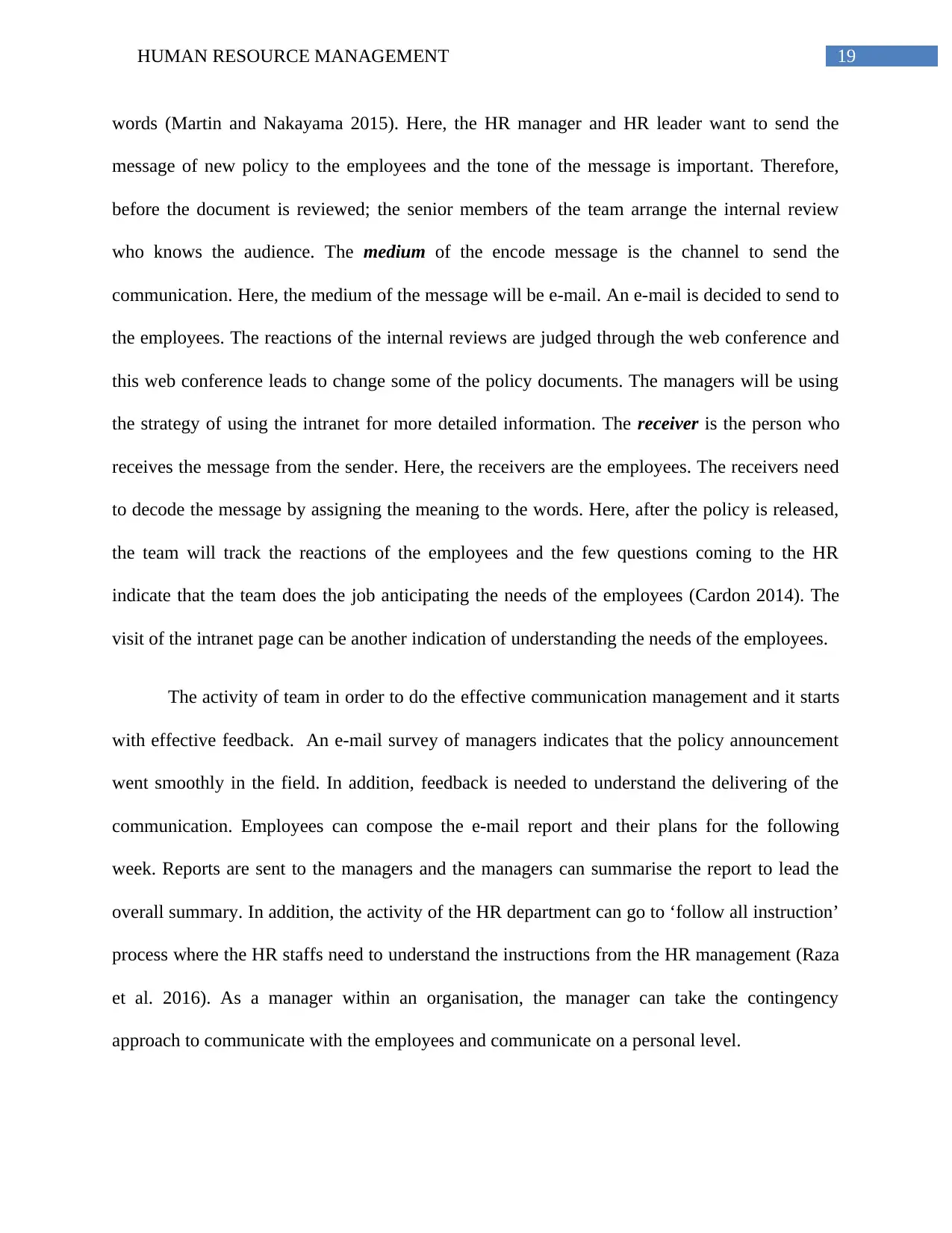
19HUMAN RESOURCE MANAGEMENT
words (Martin and Nakayama 2015). Here, the HR manager and HR leader want to send the
message of new policy to the employees and the tone of the message is important. Therefore,
before the document is reviewed; the senior members of the team arrange the internal review
who knows the audience. The medium of the encode message is the channel to send the
communication. Here, the medium of the message will be e-mail. An e-mail is decided to send to
the employees. The reactions of the internal reviews are judged through the web conference and
this web conference leads to change some of the policy documents. The managers will be using
the strategy of using the intranet for more detailed information. The receiver is the person who
receives the message from the sender. Here, the receivers are the employees. The receivers need
to decode the message by assigning the meaning to the words. Here, after the policy is released,
the team will track the reactions of the employees and the few questions coming to the HR
indicate that the team does the job anticipating the needs of the employees (Cardon 2014). The
visit of the intranet page can be another indication of understanding the needs of the employees.
The activity of team in order to do the effective communication management and it starts
with effective feedback. An e-mail survey of managers indicates that the policy announcement
went smoothly in the field. In addition, feedback is needed to understand the delivering of the
communication. Employees can compose the e-mail report and their plans for the following
week. Reports are sent to the managers and the managers can summarise the report to lead the
overall summary. In addition, the activity of the HR department can go to ‘follow all instruction’
process where the HR staffs need to understand the instructions from the HR management (Raza
et al. 2016). As a manager within an organisation, the manager can take the contingency
approach to communicate with the employees and communicate on a personal level.
words (Martin and Nakayama 2015). Here, the HR manager and HR leader want to send the
message of new policy to the employees and the tone of the message is important. Therefore,
before the document is reviewed; the senior members of the team arrange the internal review
who knows the audience. The medium of the encode message is the channel to send the
communication. Here, the medium of the message will be e-mail. An e-mail is decided to send to
the employees. The reactions of the internal reviews are judged through the web conference and
this web conference leads to change some of the policy documents. The managers will be using
the strategy of using the intranet for more detailed information. The receiver is the person who
receives the message from the sender. Here, the receivers are the employees. The receivers need
to decode the message by assigning the meaning to the words. Here, after the policy is released,
the team will track the reactions of the employees and the few questions coming to the HR
indicate that the team does the job anticipating the needs of the employees (Cardon 2014). The
visit of the intranet page can be another indication of understanding the needs of the employees.
The activity of team in order to do the effective communication management and it starts
with effective feedback. An e-mail survey of managers indicates that the policy announcement
went smoothly in the field. In addition, feedback is needed to understand the delivering of the
communication. Employees can compose the e-mail report and their plans for the following
week. Reports are sent to the managers and the managers can summarise the report to lead the
overall summary. In addition, the activity of the HR department can go to ‘follow all instruction’
process where the HR staffs need to understand the instructions from the HR management (Raza
et al. 2016). As a manager within an organisation, the manager can take the contingency
approach to communicate with the employees and communicate on a personal level.
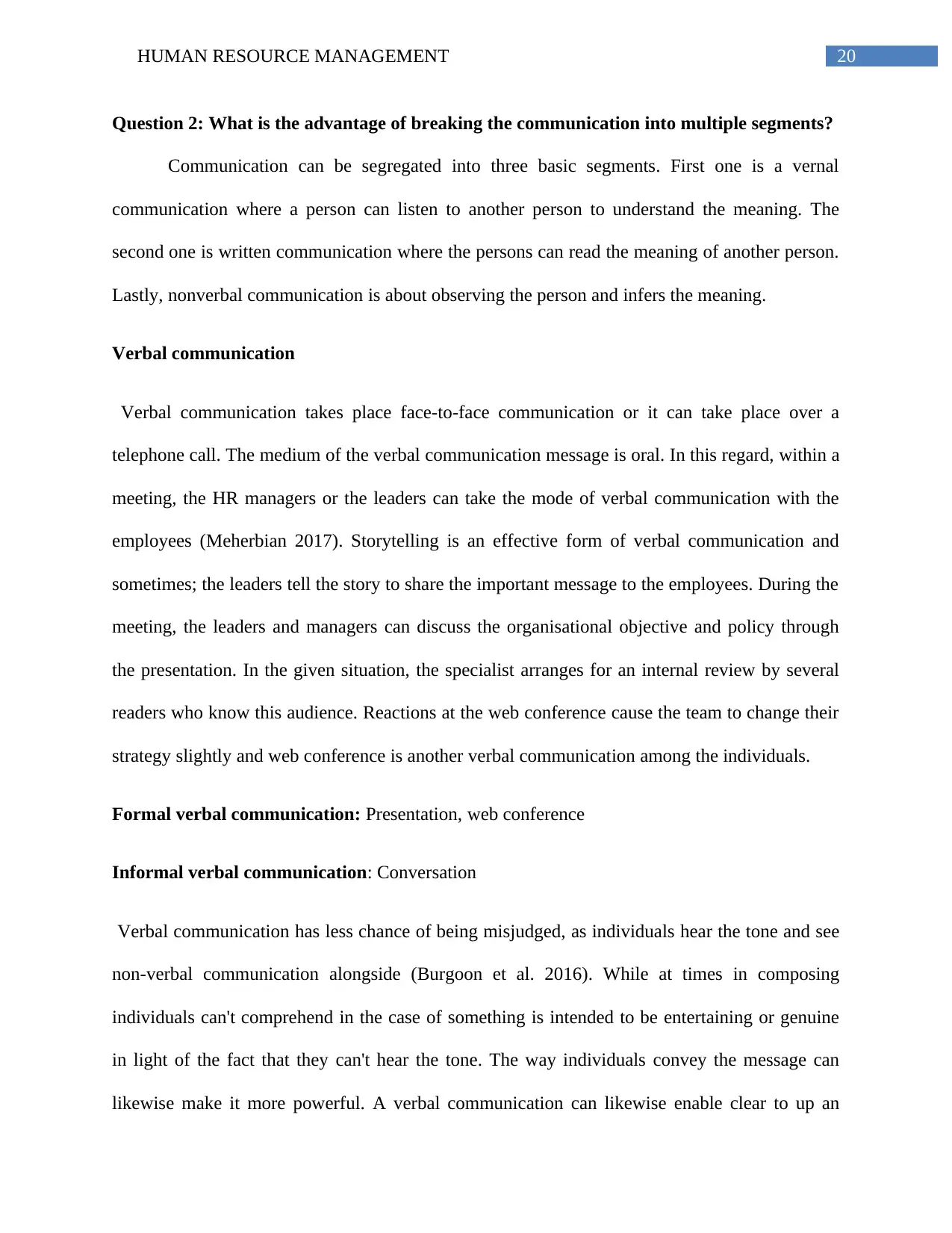
20HUMAN RESOURCE MANAGEMENT
Question 2: What is the advantage of breaking the communication into multiple segments?
Communication can be segregated into three basic segments. First one is a vernal
communication where a person can listen to another person to understand the meaning. The
second one is written communication where the persons can read the meaning of another person.
Lastly, nonverbal communication is about observing the person and infers the meaning.
Verbal communication
Verbal communication takes place face-to-face communication or it can take place over a
telephone call. The medium of the verbal communication message is oral. In this regard, within a
meeting, the HR managers or the leaders can take the mode of verbal communication with the
employees (Meherbian 2017). Storytelling is an effective form of verbal communication and
sometimes; the leaders tell the story to share the important message to the employees. During the
meeting, the leaders and managers can discuss the organisational objective and policy through
the presentation. In the given situation, the specialist arranges for an internal review by several
readers who know this audience. Reactions at the web conference cause the team to change their
strategy slightly and web conference is another verbal communication among the individuals.
Formal verbal communication: Presentation, web conference
Informal verbal communication: Conversation
Verbal communication has less chance of being misjudged, as individuals hear the tone and see
non-verbal communication alongside (Burgoon et al. 2016). While at times in composing
individuals can't comprehend in the case of something is intended to be entertaining or genuine
in light of the fact that they can't hear the tone. The way individuals convey the message can
likewise make it more powerful. A verbal communication can likewise enable clear to up an
Question 2: What is the advantage of breaking the communication into multiple segments?
Communication can be segregated into three basic segments. First one is a vernal
communication where a person can listen to another person to understand the meaning. The
second one is written communication where the persons can read the meaning of another person.
Lastly, nonverbal communication is about observing the person and infers the meaning.
Verbal communication
Verbal communication takes place face-to-face communication or it can take place over a
telephone call. The medium of the verbal communication message is oral. In this regard, within a
meeting, the HR managers or the leaders can take the mode of verbal communication with the
employees (Meherbian 2017). Storytelling is an effective form of verbal communication and
sometimes; the leaders tell the story to share the important message to the employees. During the
meeting, the leaders and managers can discuss the organisational objective and policy through
the presentation. In the given situation, the specialist arranges for an internal review by several
readers who know this audience. Reactions at the web conference cause the team to change their
strategy slightly and web conference is another verbal communication among the individuals.
Formal verbal communication: Presentation, web conference
Informal verbal communication: Conversation
Verbal communication has less chance of being misjudged, as individuals hear the tone and see
non-verbal communication alongside (Burgoon et al. 2016). While at times in composing
individuals can't comprehend in the case of something is intended to be entertaining or genuine
in light of the fact that they can't hear the tone. The way individuals convey the message can
likewise make it more powerful. A verbal communication can likewise enable clear to up an
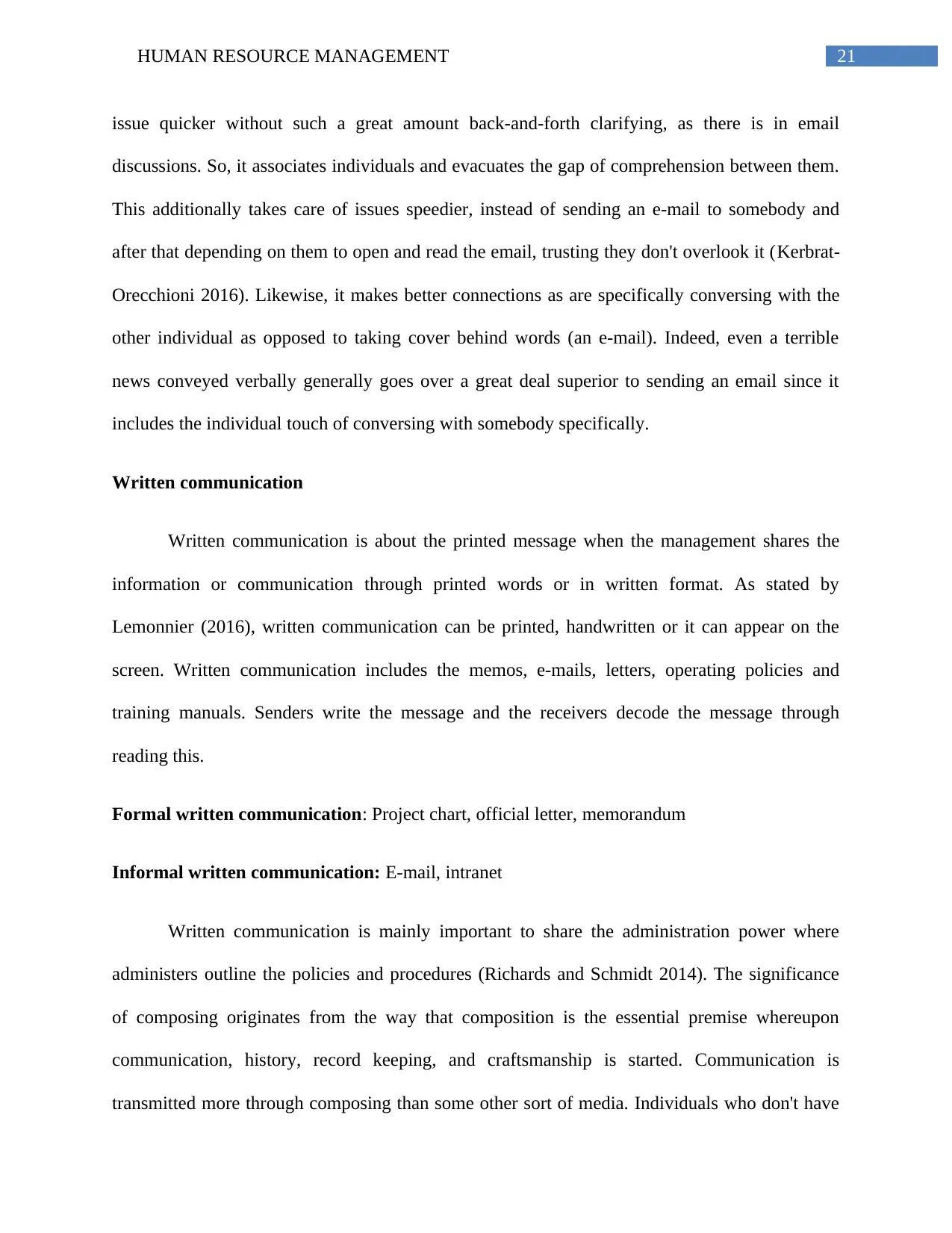
21HUMAN RESOURCE MANAGEMENT
issue quicker without such a great amount back-and-forth clarifying, as there is in email
discussions. So, it associates individuals and evacuates the gap of comprehension between them.
This additionally takes care of issues speedier, instead of sending an e-mail to somebody and
after that depending on them to open and read the email, trusting they don't overlook it (Kerbrat-
Orecchioni 2016). Likewise, it makes better connections as are specifically conversing with the
other individual as opposed to taking cover behind words (an e-mail). Indeed, even a terrible
news conveyed verbally generally goes over a great deal superior to sending an email since it
includes the individual touch of conversing with somebody specifically.
Written communication
Written communication is about the printed message when the management shares the
information or communication through printed words or in written format. As stated by
Lemonnier (2016), written communication can be printed, handwritten or it can appear on the
screen. Written communication includes the memos, e-mails, letters, operating policies and
training manuals. Senders write the message and the receivers decode the message through
reading this.
Formal written communication: Project chart, official letter, memorandum
Informal written communication: E-mail, intranet
Written communication is mainly important to share the administration power where
administers outline the policies and procedures (Richards and Schmidt 2014). The significance
of composing originates from the way that composition is the essential premise whereupon
communication, history, record keeping, and craftsmanship is started. Communication is
transmitted more through composing than some other sort of media. Individuals who don't have
issue quicker without such a great amount back-and-forth clarifying, as there is in email
discussions. So, it associates individuals and evacuates the gap of comprehension between them.
This additionally takes care of issues speedier, instead of sending an e-mail to somebody and
after that depending on them to open and read the email, trusting they don't overlook it (Kerbrat-
Orecchioni 2016). Likewise, it makes better connections as are specifically conversing with the
other individual as opposed to taking cover behind words (an e-mail). Indeed, even a terrible
news conveyed verbally generally goes over a great deal superior to sending an email since it
includes the individual touch of conversing with somebody specifically.
Written communication
Written communication is about the printed message when the management shares the
information or communication through printed words or in written format. As stated by
Lemonnier (2016), written communication can be printed, handwritten or it can appear on the
screen. Written communication includes the memos, e-mails, letters, operating policies and
training manuals. Senders write the message and the receivers decode the message through
reading this.
Formal written communication: Project chart, official letter, memorandum
Informal written communication: E-mail, intranet
Written communication is mainly important to share the administration power where
administers outline the policies and procedures (Richards and Schmidt 2014). The significance
of composing originates from the way that composition is the essential premise whereupon
communication, history, record keeping, and craftsmanship is started. Communication is
transmitted more through composing than some other sort of media. Individuals who don't have
Paraphrase This Document
Need a fresh take? Get an instant paraphrase of this document with our AI Paraphraser
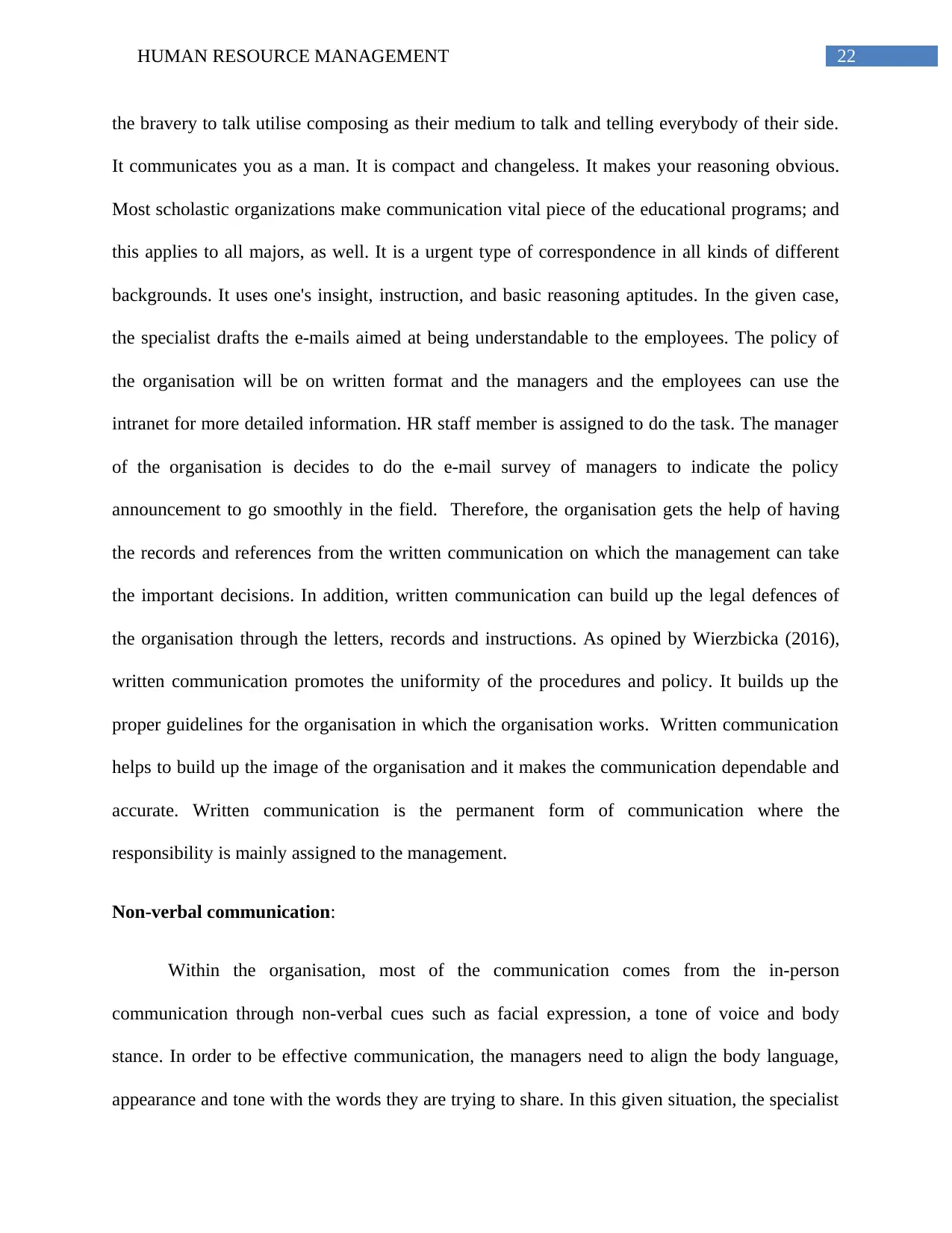
22HUMAN RESOURCE MANAGEMENT
the bravery to talk utilise composing as their medium to talk and telling everybody of their side.
It communicates you as a man. It is compact and changeless. It makes your reasoning obvious.
Most scholastic organizations make communication vital piece of the educational programs; and
this applies to all majors, as well. It is a urgent type of correspondence in all kinds of different
backgrounds. It uses one's insight, instruction, and basic reasoning aptitudes. In the given case,
the specialist drafts the e-mails aimed at being understandable to the employees. The policy of
the organisation will be on written format and the managers and the employees can use the
intranet for more detailed information. HR staff member is assigned to do the task. The manager
of the organisation is decides to do the e-mail survey of managers to indicate the policy
announcement to go smoothly in the field. Therefore, the organisation gets the help of having
the records and references from the written communication on which the management can take
the important decisions. In addition, written communication can build up the legal defences of
the organisation through the letters, records and instructions. As opined by Wierzbicka (2016),
written communication promotes the uniformity of the procedures and policy. It builds up the
proper guidelines for the organisation in which the organisation works. Written communication
helps to build up the image of the organisation and it makes the communication dependable and
accurate. Written communication is the permanent form of communication where the
responsibility is mainly assigned to the management.
Non-verbal communication:
Within the organisation, most of the communication comes from the in-person
communication through non-verbal cues such as facial expression, a tone of voice and body
stance. In order to be effective communication, the managers need to align the body language,
appearance and tone with the words they are trying to share. In this given situation, the specialist
the bravery to talk utilise composing as their medium to talk and telling everybody of their side.
It communicates you as a man. It is compact and changeless. It makes your reasoning obvious.
Most scholastic organizations make communication vital piece of the educational programs; and
this applies to all majors, as well. It is a urgent type of correspondence in all kinds of different
backgrounds. It uses one's insight, instruction, and basic reasoning aptitudes. In the given case,
the specialist drafts the e-mails aimed at being understandable to the employees. The policy of
the organisation will be on written format and the managers and the employees can use the
intranet for more detailed information. HR staff member is assigned to do the task. The manager
of the organisation is decides to do the e-mail survey of managers to indicate the policy
announcement to go smoothly in the field. Therefore, the organisation gets the help of having
the records and references from the written communication on which the management can take
the important decisions. In addition, written communication can build up the legal defences of
the organisation through the letters, records and instructions. As opined by Wierzbicka (2016),
written communication promotes the uniformity of the procedures and policy. It builds up the
proper guidelines for the organisation in which the organisation works. Written communication
helps to build up the image of the organisation and it makes the communication dependable and
accurate. Written communication is the permanent form of communication where the
responsibility is mainly assigned to the management.
Non-verbal communication:
Within the organisation, most of the communication comes from the in-person
communication through non-verbal cues such as facial expression, a tone of voice and body
stance. In order to be effective communication, the managers need to align the body language,
appearance and tone with the words they are trying to share. In this given situation, the specialist
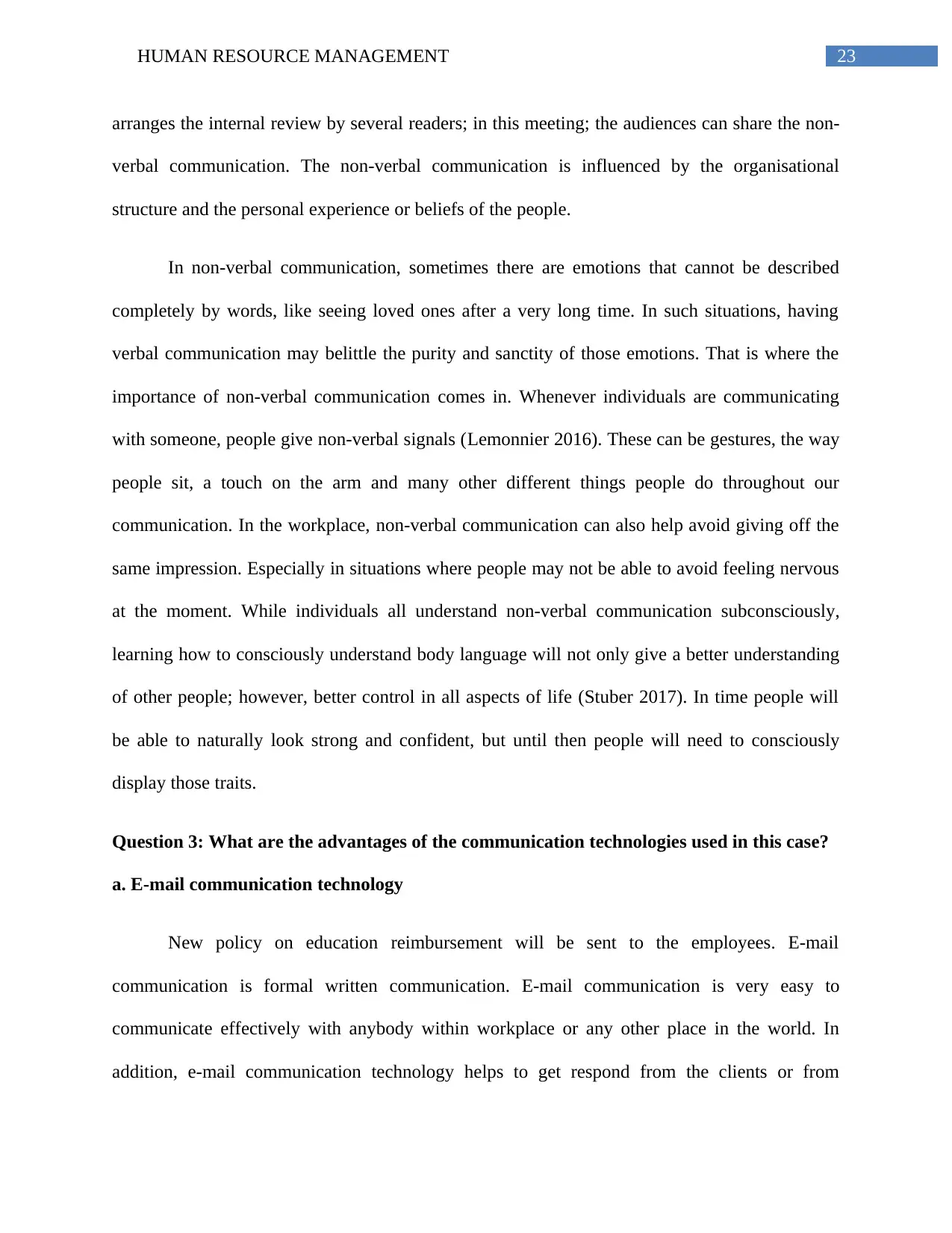
23HUMAN RESOURCE MANAGEMENT
arranges the internal review by several readers; in this meeting; the audiences can share the non-
verbal communication. The non-verbal communication is influenced by the organisational
structure and the personal experience or beliefs of the people.
In non-verbal communication, sometimes there are emotions that cannot be described
completely by words, like seeing loved ones after a very long time. In such situations, having
verbal communication may belittle the purity and sanctity of those emotions. That is where the
importance of non-verbal communication comes in. Whenever individuals are communicating
with someone, people give non-verbal signals (Lemonnier 2016). These can be gestures, the way
people sit, a touch on the arm and many other different things people do throughout our
communication. In the workplace, non-verbal communication can also help avoid giving off the
same impression. Especially in situations where people may not be able to avoid feeling nervous
at the moment. While individuals all understand non-verbal communication subconsciously,
learning how to consciously understand body language will not only give a better understanding
of other people; however, better control in all aspects of life (Stuber 2017). In time people will
be able to naturally look strong and confident, but until then people will need to consciously
display those traits.
Question 3: What are the advantages of the communication technologies used in this case?
a. E-mail communication technology
New policy on education reimbursement will be sent to the employees. E-mail
communication is formal written communication. E-mail communication is very easy to
communicate effectively with anybody within workplace or any other place in the world. In
addition, e-mail communication technology helps to get respond from the clients or from
arranges the internal review by several readers; in this meeting; the audiences can share the non-
verbal communication. The non-verbal communication is influenced by the organisational
structure and the personal experience or beliefs of the people.
In non-verbal communication, sometimes there are emotions that cannot be described
completely by words, like seeing loved ones after a very long time. In such situations, having
verbal communication may belittle the purity and sanctity of those emotions. That is where the
importance of non-verbal communication comes in. Whenever individuals are communicating
with someone, people give non-verbal signals (Lemonnier 2016). These can be gestures, the way
people sit, a touch on the arm and many other different things people do throughout our
communication. In the workplace, non-verbal communication can also help avoid giving off the
same impression. Especially in situations where people may not be able to avoid feeling nervous
at the moment. While individuals all understand non-verbal communication subconsciously,
learning how to consciously understand body language will not only give a better understanding
of other people; however, better control in all aspects of life (Stuber 2017). In time people will
be able to naturally look strong and confident, but until then people will need to consciously
display those traits.
Question 3: What are the advantages of the communication technologies used in this case?
a. E-mail communication technology
New policy on education reimbursement will be sent to the employees. E-mail
communication is formal written communication. E-mail communication is very easy to
communicate effectively with anybody within workplace or any other place in the world. In
addition, e-mail communication technology helps to get respond from the clients or from
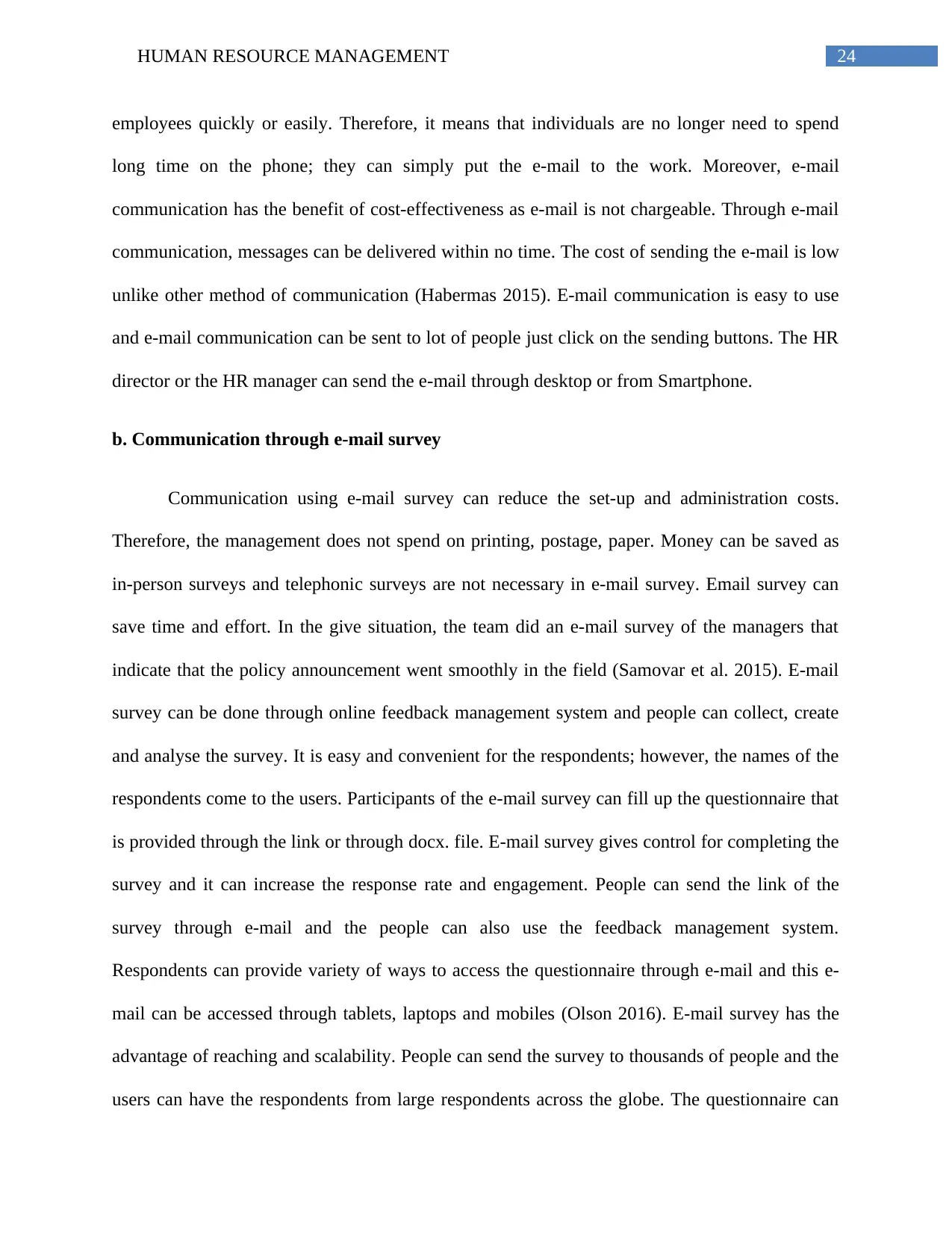
24HUMAN RESOURCE MANAGEMENT
employees quickly or easily. Therefore, it means that individuals are no longer need to spend
long time on the phone; they can simply put the e-mail to the work. Moreover, e-mail
communication has the benefit of cost-effectiveness as e-mail is not chargeable. Through e-mail
communication, messages can be delivered within no time. The cost of sending the e-mail is low
unlike other method of communication (Habermas 2015). E-mail communication is easy to use
and e-mail communication can be sent to lot of people just click on the sending buttons. The HR
director or the HR manager can send the e-mail through desktop or from Smartphone.
b. Communication through e-mail survey
Communication using e-mail survey can reduce the set-up and administration costs.
Therefore, the management does not spend on printing, postage, paper. Money can be saved as
in-person surveys and telephonic surveys are not necessary in e-mail survey. Email survey can
save time and effort. In the give situation, the team did an e-mail survey of the managers that
indicate that the policy announcement went smoothly in the field (Samovar et al. 2015). E-mail
survey can be done through online feedback management system and people can collect, create
and analyse the survey. It is easy and convenient for the respondents; however, the names of the
respondents come to the users. Participants of the e-mail survey can fill up the questionnaire that
is provided through the link or through docx. file. E-mail survey gives control for completing the
survey and it can increase the response rate and engagement. People can send the link of the
survey through e-mail and the people can also use the feedback management system.
Respondents can provide variety of ways to access the questionnaire through e-mail and this e-
mail can be accessed through tablets, laptops and mobiles (Olson 2016). E-mail survey has the
advantage of reaching and scalability. People can send the survey to thousands of people and the
users can have the respondents from large respondents across the globe. The questionnaire can
employees quickly or easily. Therefore, it means that individuals are no longer need to spend
long time on the phone; they can simply put the e-mail to the work. Moreover, e-mail
communication has the benefit of cost-effectiveness as e-mail is not chargeable. Through e-mail
communication, messages can be delivered within no time. The cost of sending the e-mail is low
unlike other method of communication (Habermas 2015). E-mail communication is easy to use
and e-mail communication can be sent to lot of people just click on the sending buttons. The HR
director or the HR manager can send the e-mail through desktop or from Smartphone.
b. Communication through e-mail survey
Communication using e-mail survey can reduce the set-up and administration costs.
Therefore, the management does not spend on printing, postage, paper. Money can be saved as
in-person surveys and telephonic surveys are not necessary in e-mail survey. Email survey can
save time and effort. In the give situation, the team did an e-mail survey of the managers that
indicate that the policy announcement went smoothly in the field (Samovar et al. 2015). E-mail
survey can be done through online feedback management system and people can collect, create
and analyse the survey. It is easy and convenient for the respondents; however, the names of the
respondents come to the users. Participants of the e-mail survey can fill up the questionnaire that
is provided through the link or through docx. file. E-mail survey gives control for completing the
survey and it can increase the response rate and engagement. People can send the link of the
survey through e-mail and the people can also use the feedback management system.
Respondents can provide variety of ways to access the questionnaire through e-mail and this e-
mail can be accessed through tablets, laptops and mobiles (Olson 2016). E-mail survey has the
advantage of reaching and scalability. People can send the survey to thousands of people and the
users can have the respondents from large respondents across the globe. The questionnaire can
Secure Best Marks with AI Grader
Need help grading? Try our AI Grader for instant feedback on your assignments.
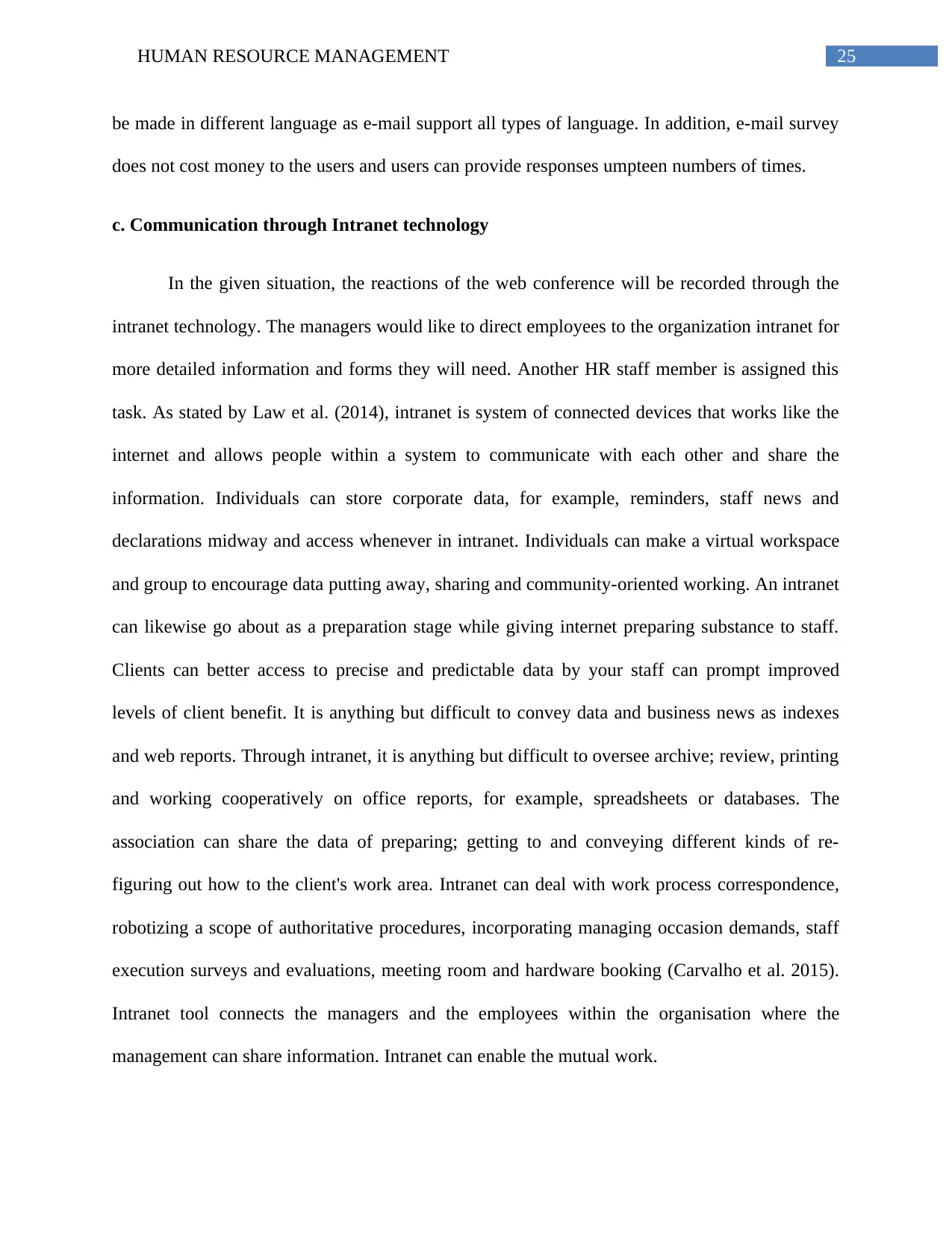
25HUMAN RESOURCE MANAGEMENT
be made in different language as e-mail support all types of language. In addition, e-mail survey
does not cost money to the users and users can provide responses umpteen numbers of times.
c. Communication through Intranet technology
In the given situation, the reactions of the web conference will be recorded through the
intranet technology. The managers would like to direct employees to the organization intranet for
more detailed information and forms they will need. Another HR staff member is assigned this
task. As stated by Law et al. (2014), intranet is system of connected devices that works like the
internet and allows people within a system to communicate with each other and share the
information. Individuals can store corporate data, for example, reminders, staff news and
declarations midway and access whenever in intranet. Individuals can make a virtual workspace
and group to encourage data putting away, sharing and community-oriented working. An intranet
can likewise go about as a preparation stage while giving internet preparing substance to staff.
Clients can better access to precise and predictable data by your staff can prompt improved
levels of client benefit. It is anything but difficult to convey data and business news as indexes
and web reports. Through intranet, it is anything but difficult to oversee archive; review, printing
and working cooperatively on office reports, for example, spreadsheets or databases. The
association can share the data of preparing; getting to and conveying different kinds of re-
figuring out how to the client's work area. Intranet can deal with work process correspondence,
robotizing a scope of authoritative procedures, incorporating managing occasion demands, staff
execution surveys and evaluations, meeting room and hardware booking (Carvalho et al. 2015).
Intranet tool connects the managers and the employees within the organisation where the
management can share information. Intranet can enable the mutual work.
be made in different language as e-mail support all types of language. In addition, e-mail survey
does not cost money to the users and users can provide responses umpteen numbers of times.
c. Communication through Intranet technology
In the given situation, the reactions of the web conference will be recorded through the
intranet technology. The managers would like to direct employees to the organization intranet for
more detailed information and forms they will need. Another HR staff member is assigned this
task. As stated by Law et al. (2014), intranet is system of connected devices that works like the
internet and allows people within a system to communicate with each other and share the
information. Individuals can store corporate data, for example, reminders, staff news and
declarations midway and access whenever in intranet. Individuals can make a virtual workspace
and group to encourage data putting away, sharing and community-oriented working. An intranet
can likewise go about as a preparation stage while giving internet preparing substance to staff.
Clients can better access to precise and predictable data by your staff can prompt improved
levels of client benefit. It is anything but difficult to convey data and business news as indexes
and web reports. Through intranet, it is anything but difficult to oversee archive; review, printing
and working cooperatively on office reports, for example, spreadsheets or databases. The
association can share the data of preparing; getting to and conveying different kinds of re-
figuring out how to the client's work area. Intranet can deal with work process correspondence,
robotizing a scope of authoritative procedures, incorporating managing occasion demands, staff
execution surveys and evaluations, meeting room and hardware booking (Carvalho et al. 2015).
Intranet tool connects the managers and the employees within the organisation where the
management can share information. Intranet can enable the mutual work.
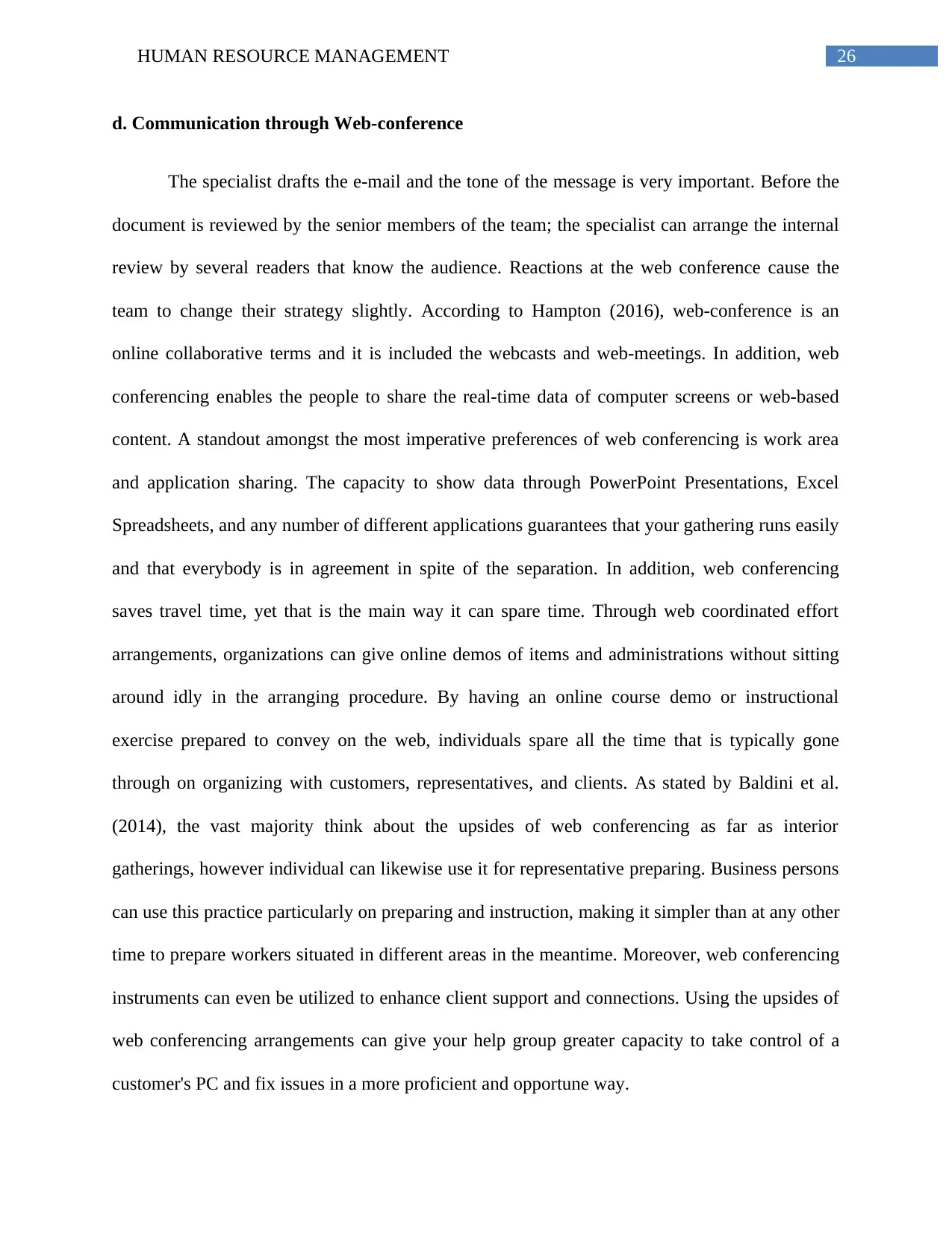
26HUMAN RESOURCE MANAGEMENT
d. Communication through Web-conference
The specialist drafts the e-mail and the tone of the message is very important. Before the
document is reviewed by the senior members of the team; the specialist can arrange the internal
review by several readers that know the audience. Reactions at the web conference cause the
team to change their strategy slightly. According to Hampton (2016), web-conference is an
online collaborative terms and it is included the webcasts and web-meetings. In addition, web
conferencing enables the people to share the real-time data of computer screens or web-based
content. A standout amongst the most imperative preferences of web conferencing is work area
and application sharing. The capacity to show data through PowerPoint Presentations, Excel
Spreadsheets, and any number of different applications guarantees that your gathering runs easily
and that everybody is in agreement in spite of the separation. In addition, web conferencing
saves travel time, yet that is the main way it can spare time. Through web coordinated effort
arrangements, organizations can give online demos of items and administrations without sitting
around idly in the arranging procedure. By having an online course demo or instructional
exercise prepared to convey on the web, individuals spare all the time that is typically gone
through on organizing with customers, representatives, and clients. As stated by Baldini et al.
(2014), the vast majority think about the upsides of web conferencing as far as interior
gatherings, however individual can likewise use it for representative preparing. Business persons
can use this practice particularly on preparing and instruction, making it simpler than at any other
time to prepare workers situated in different areas in the meantime. Moreover, web conferencing
instruments can even be utilized to enhance client support and connections. Using the upsides of
web conferencing arrangements can give your help group greater capacity to take control of a
customer's PC and fix issues in a more proficient and opportune way.
d. Communication through Web-conference
The specialist drafts the e-mail and the tone of the message is very important. Before the
document is reviewed by the senior members of the team; the specialist can arrange the internal
review by several readers that know the audience. Reactions at the web conference cause the
team to change their strategy slightly. According to Hampton (2016), web-conference is an
online collaborative terms and it is included the webcasts and web-meetings. In addition, web
conferencing enables the people to share the real-time data of computer screens or web-based
content. A standout amongst the most imperative preferences of web conferencing is work area
and application sharing. The capacity to show data through PowerPoint Presentations, Excel
Spreadsheets, and any number of different applications guarantees that your gathering runs easily
and that everybody is in agreement in spite of the separation. In addition, web conferencing
saves travel time, yet that is the main way it can spare time. Through web coordinated effort
arrangements, organizations can give online demos of items and administrations without sitting
around idly in the arranging procedure. By having an online course demo or instructional
exercise prepared to convey on the web, individuals spare all the time that is typically gone
through on organizing with customers, representatives, and clients. As stated by Baldini et al.
(2014), the vast majority think about the upsides of web conferencing as far as interior
gatherings, however individual can likewise use it for representative preparing. Business persons
can use this practice particularly on preparing and instruction, making it simpler than at any other
time to prepare workers situated in different areas in the meantime. Moreover, web conferencing
instruments can even be utilized to enhance client support and connections. Using the upsides of
web conferencing arrangements can give your help group greater capacity to take control of a
customer's PC and fix issues in a more proficient and opportune way.

27HUMAN RESOURCE MANAGEMENT
Question 4: How is this communication improved through feedback? What impact does
cross culture has on communication.
Within the organisation, managers try to institutionalise the feedback so that the management
get to know about what the employees and middle management think about the new policy. In
the given situation, the team wants to start the e-mail survey so that the managers can send their
views about the new policy of education within the organisation. Communication can be
improved through feedback as feedback can give praises or it can also provide constructive
criticism. As stated by Sharma and Sharma (2017), receivers of the communication are not just
passive observers. The receivers receive the message and the receivers can respond on the
message. The response of the receiver on senders’ message is called the feedback. Therefore,
feedback is the audiences’ responses and feedback enables the audiences to evaluate the
effectiveness of the message. In the given situation, the management wanted to know what the
managers and employees think about the new education reimbursement policy. As stated by Qiu
et al. (2016), giving the audience a chance give the feedback is crucial for sharing the open
communication. The managers need to create environment where the employees like to share the
feedback. It is important to allow the subordinates to share the feedback. Feedback is essential i
the communication process as to know whether the receivers understand the message in the same
term as it intended by the sender. There are many ways that the organisation takes the feedback
from the managers and from the employees; such as memos, e-mails, open-door policies,
surveys, company newsletters and e-mail survey. In the given situation, the HR organisation
wanted to take the feedback from the managers using e-mail survey. Sometimes, they utilised the
internal review method. The managers use the feedback to ensure focus on particular behaviour
of the employees and it can be specific rather than being general. The feedback can be
Question 4: How is this communication improved through feedback? What impact does
cross culture has on communication.
Within the organisation, managers try to institutionalise the feedback so that the management
get to know about what the employees and middle management think about the new policy. In
the given situation, the team wants to start the e-mail survey so that the managers can send their
views about the new policy of education within the organisation. Communication can be
improved through feedback as feedback can give praises or it can also provide constructive
criticism. As stated by Sharma and Sharma (2017), receivers of the communication are not just
passive observers. The receivers receive the message and the receivers can respond on the
message. The response of the receiver on senders’ message is called the feedback. Therefore,
feedback is the audiences’ responses and feedback enables the audiences to evaluate the
effectiveness of the message. In the given situation, the management wanted to know what the
managers and employees think about the new education reimbursement policy. As stated by Qiu
et al. (2016), giving the audience a chance give the feedback is crucial for sharing the open
communication. The managers need to create environment where the employees like to share the
feedback. It is important to allow the subordinates to share the feedback. Feedback is essential i
the communication process as to know whether the receivers understand the message in the same
term as it intended by the sender. There are many ways that the organisation takes the feedback
from the managers and from the employees; such as memos, e-mails, open-door policies,
surveys, company newsletters and e-mail survey. In the given situation, the HR organisation
wanted to take the feedback from the managers using e-mail survey. Sometimes, they utilised the
internal review method. The managers use the feedback to ensure focus on particular behaviour
of the employees and it can be specific rather than being general. The feedback can be
Paraphrase This Document
Need a fresh take? Get an instant paraphrase of this document with our AI Paraphraser
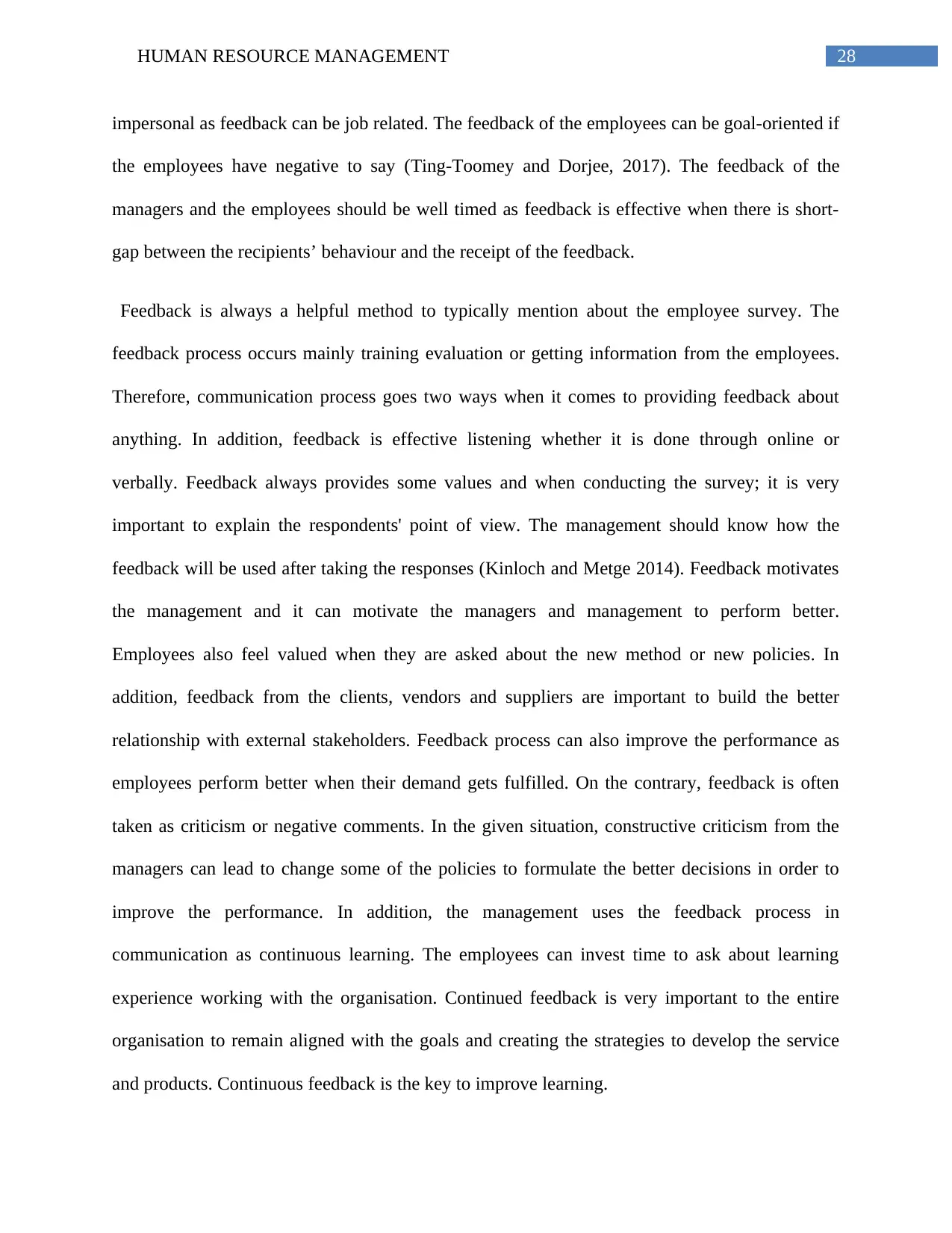
28HUMAN RESOURCE MANAGEMENT
impersonal as feedback can be job related. The feedback of the employees can be goal-oriented if
the employees have negative to say (Ting-Toomey and Dorjee, 2017). The feedback of the
managers and the employees should be well timed as feedback is effective when there is short-
gap between the recipients’ behaviour and the receipt of the feedback.
Feedback is always a helpful method to typically mention about the employee survey. The
feedback process occurs mainly training evaluation or getting information from the employees.
Therefore, communication process goes two ways when it comes to providing feedback about
anything. In addition, feedback is effective listening whether it is done through online or
verbally. Feedback always provides some values and when conducting the survey; it is very
important to explain the respondents' point of view. The management should know how the
feedback will be used after taking the responses (Kinloch and Metge 2014). Feedback motivates
the management and it can motivate the managers and management to perform better.
Employees also feel valued when they are asked about the new method or new policies. In
addition, feedback from the clients, vendors and suppliers are important to build the better
relationship with external stakeholders. Feedback process can also improve the performance as
employees perform better when their demand gets fulfilled. On the contrary, feedback is often
taken as criticism or negative comments. In the given situation, constructive criticism from the
managers can lead to change some of the policies to formulate the better decisions in order to
improve the performance. In addition, the management uses the feedback process in
communication as continuous learning. The employees can invest time to ask about learning
experience working with the organisation. Continued feedback is very important to the entire
organisation to remain aligned with the goals and creating the strategies to develop the service
and products. Continuous feedback is the key to improve learning.
impersonal as feedback can be job related. The feedback of the employees can be goal-oriented if
the employees have negative to say (Ting-Toomey and Dorjee, 2017). The feedback of the
managers and the employees should be well timed as feedback is effective when there is short-
gap between the recipients’ behaviour and the receipt of the feedback.
Feedback is always a helpful method to typically mention about the employee survey. The
feedback process occurs mainly training evaluation or getting information from the employees.
Therefore, communication process goes two ways when it comes to providing feedback about
anything. In addition, feedback is effective listening whether it is done through online or
verbally. Feedback always provides some values and when conducting the survey; it is very
important to explain the respondents' point of view. The management should know how the
feedback will be used after taking the responses (Kinloch and Metge 2014). Feedback motivates
the management and it can motivate the managers and management to perform better.
Employees also feel valued when they are asked about the new method or new policies. In
addition, feedback from the clients, vendors and suppliers are important to build the better
relationship with external stakeholders. Feedback process can also improve the performance as
employees perform better when their demand gets fulfilled. On the contrary, feedback is often
taken as criticism or negative comments. In the given situation, constructive criticism from the
managers can lead to change some of the policies to formulate the better decisions in order to
improve the performance. In addition, the management uses the feedback process in
communication as continuous learning. The employees can invest time to ask about learning
experience working with the organisation. Continued feedback is very important to the entire
organisation to remain aligned with the goals and creating the strategies to develop the service
and products. Continuous feedback is the key to improve learning.
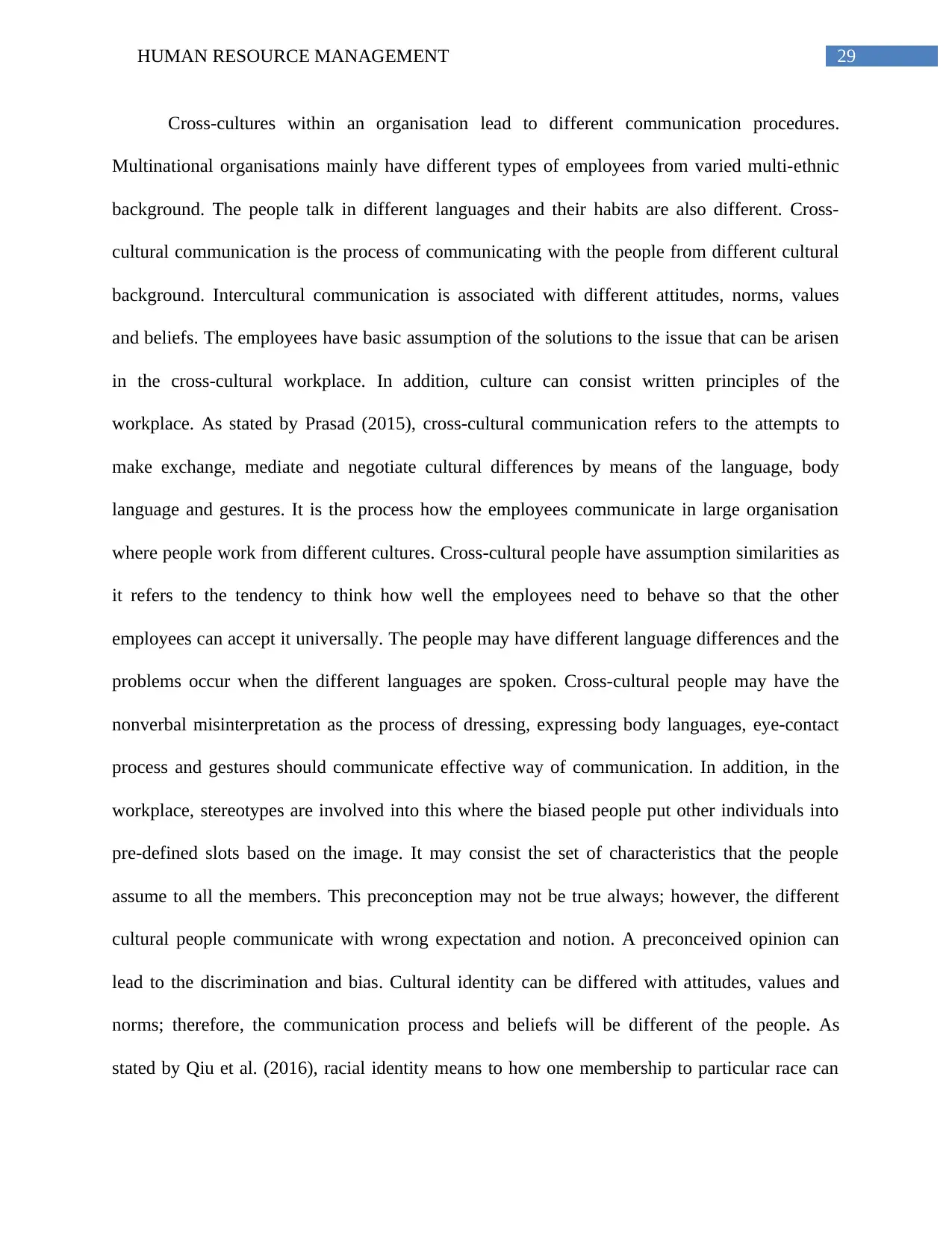
29HUMAN RESOURCE MANAGEMENT
Cross-cultures within an organisation lead to different communication procedures.
Multinational organisations mainly have different types of employees from varied multi-ethnic
background. The people talk in different languages and their habits are also different. Cross-
cultural communication is the process of communicating with the people from different cultural
background. Intercultural communication is associated with different attitudes, norms, values
and beliefs. The employees have basic assumption of the solutions to the issue that can be arisen
in the cross-cultural workplace. In addition, culture can consist written principles of the
workplace. As stated by Prasad (2015), cross-cultural communication refers to the attempts to
make exchange, mediate and negotiate cultural differences by means of the language, body
language and gestures. It is the process how the employees communicate in large organisation
where people work from different cultures. Cross-cultural people have assumption similarities as
it refers to the tendency to think how well the employees need to behave so that the other
employees can accept it universally. The people may have different language differences and the
problems occur when the different languages are spoken. Cross-cultural people may have the
nonverbal misinterpretation as the process of dressing, expressing body languages, eye-contact
process and gestures should communicate effective way of communication. In addition, in the
workplace, stereotypes are involved into this where the biased people put other individuals into
pre-defined slots based on the image. It may consist the set of characteristics that the people
assume to all the members. This preconception may not be true always; however, the different
cultural people communicate with wrong expectation and notion. A preconceived opinion can
lead to the discrimination and bias. Cultural identity can be differed with attitudes, values and
norms; therefore, the communication process and beliefs will be different of the people. As
stated by Qiu et al. (2016), racial identity means to how one membership to particular race can
Cross-cultures within an organisation lead to different communication procedures.
Multinational organisations mainly have different types of employees from varied multi-ethnic
background. The people talk in different languages and their habits are also different. Cross-
cultural communication is the process of communicating with the people from different cultural
background. Intercultural communication is associated with different attitudes, norms, values
and beliefs. The employees have basic assumption of the solutions to the issue that can be arisen
in the cross-cultural workplace. In addition, culture can consist written principles of the
workplace. As stated by Prasad (2015), cross-cultural communication refers to the attempts to
make exchange, mediate and negotiate cultural differences by means of the language, body
language and gestures. It is the process how the employees communicate in large organisation
where people work from different cultures. Cross-cultural people have assumption similarities as
it refers to the tendency to think how well the employees need to behave so that the other
employees can accept it universally. The people may have different language differences and the
problems occur when the different languages are spoken. Cross-cultural people may have the
nonverbal misinterpretation as the process of dressing, expressing body languages, eye-contact
process and gestures should communicate effective way of communication. In addition, in the
workplace, stereotypes are involved into this where the biased people put other individuals into
pre-defined slots based on the image. It may consist the set of characteristics that the people
assume to all the members. This preconception may not be true always; however, the different
cultural people communicate with wrong expectation and notion. A preconceived opinion can
lead to the discrimination and bias. Cultural identity can be differed with attitudes, values and
norms; therefore, the communication process and beliefs will be different of the people. As
stated by Qiu et al. (2016), racial identity means to how one membership to particular race can
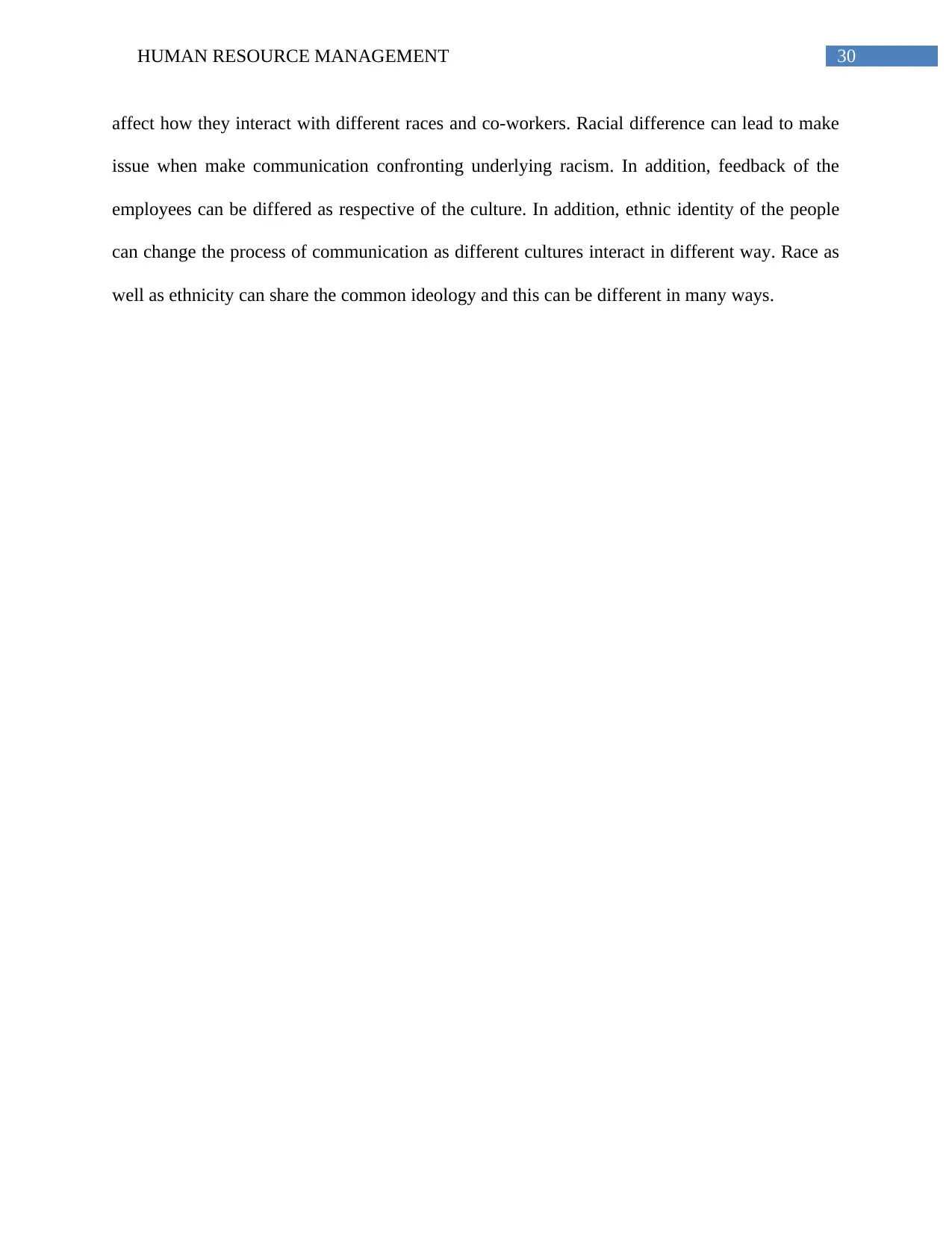
30HUMAN RESOURCE MANAGEMENT
affect how they interact with different races and co-workers. Racial difference can lead to make
issue when make communication confronting underlying racism. In addition, feedback of the
employees can be differed as respective of the culture. In addition, ethnic identity of the people
can change the process of communication as different cultures interact in different way. Race as
well as ethnicity can share the common ideology and this can be different in many ways.
affect how they interact with different races and co-workers. Racial difference can lead to make
issue when make communication confronting underlying racism. In addition, feedback of the
employees can be differed as respective of the culture. In addition, ethnic identity of the people
can change the process of communication as different cultures interact in different way. Race as
well as ethnicity can share the common ideology and this can be different in many ways.
Secure Best Marks with AI Grader
Need help grading? Try our AI Grader for instant feedback on your assignments.
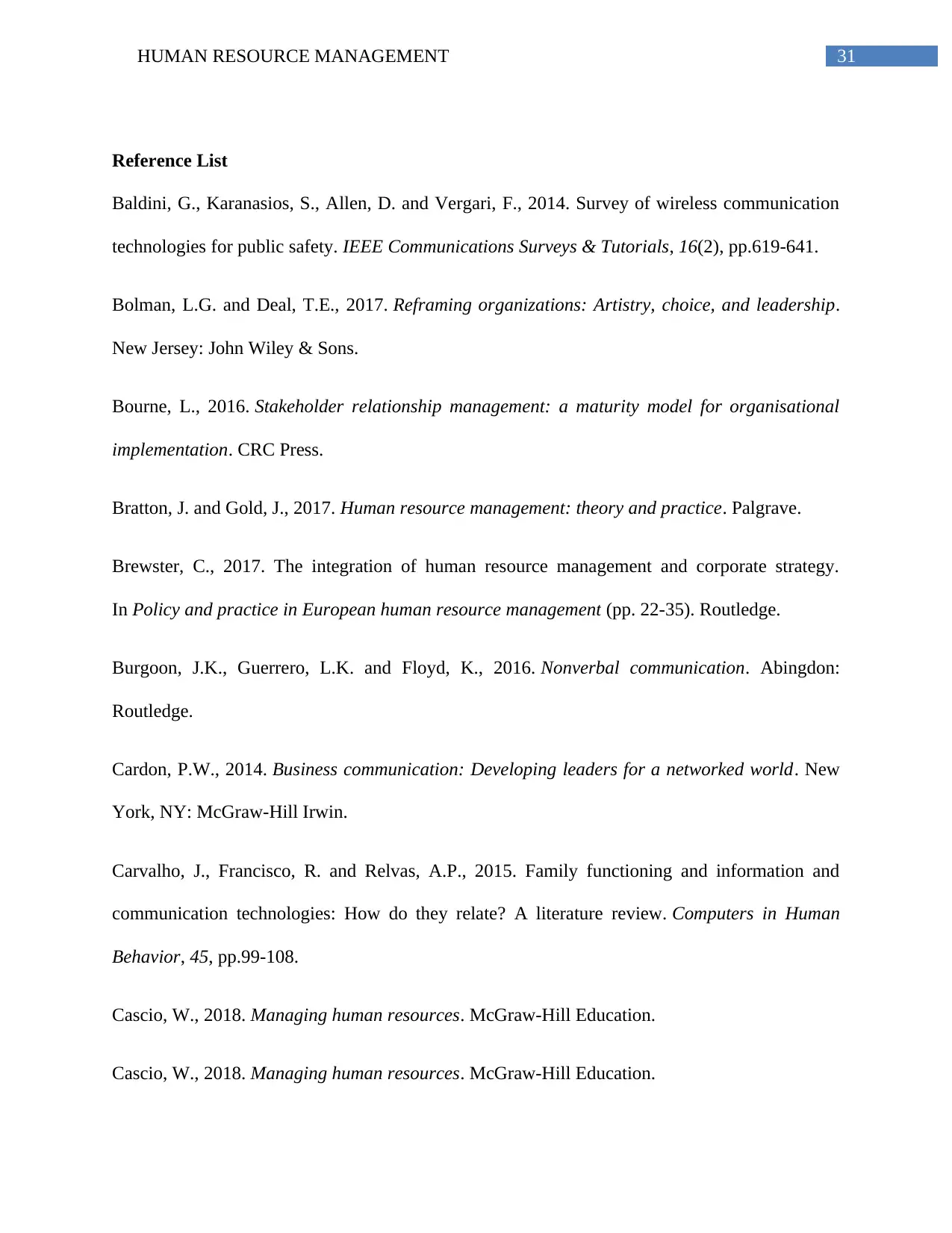
31HUMAN RESOURCE MANAGEMENT
Reference List
Baldini, G., Karanasios, S., Allen, D. and Vergari, F., 2014. Survey of wireless communication
technologies for public safety. IEEE Communications Surveys & Tutorials, 16(2), pp.619-641.
Bolman, L.G. and Deal, T.E., 2017. Reframing organizations: Artistry, choice, and leadership.
New Jersey: John Wiley & Sons.
Bourne, L., 2016. Stakeholder relationship management: a maturity model for organisational
implementation. CRC Press.
Bratton, J. and Gold, J., 2017. Human resource management: theory and practice. Palgrave.
Brewster, C., 2017. The integration of human resource management and corporate strategy.
In Policy and practice in European human resource management (pp. 22-35). Routledge.
Burgoon, J.K., Guerrero, L.K. and Floyd, K., 2016. Nonverbal communication. Abingdon:
Routledge.
Cardon, P.W., 2014. Business communication: Developing leaders for a networked world. New
York, NY: McGraw-Hill Irwin.
Carvalho, J., Francisco, R. and Relvas, A.P., 2015. Family functioning and information and
communication technologies: How do they relate? A literature review. Computers in Human
Behavior, 45, pp.99-108.
Cascio, W., 2018. Managing human resources. McGraw-Hill Education.
Cascio, W., 2018. Managing human resources. McGraw-Hill Education.
Reference List
Baldini, G., Karanasios, S., Allen, D. and Vergari, F., 2014. Survey of wireless communication
technologies for public safety. IEEE Communications Surveys & Tutorials, 16(2), pp.619-641.
Bolman, L.G. and Deal, T.E., 2017. Reframing organizations: Artistry, choice, and leadership.
New Jersey: John Wiley & Sons.
Bourne, L., 2016. Stakeholder relationship management: a maturity model for organisational
implementation. CRC Press.
Bratton, J. and Gold, J., 2017. Human resource management: theory and practice. Palgrave.
Brewster, C., 2017. The integration of human resource management and corporate strategy.
In Policy and practice in European human resource management (pp. 22-35). Routledge.
Burgoon, J.K., Guerrero, L.K. and Floyd, K., 2016. Nonverbal communication. Abingdon:
Routledge.
Cardon, P.W., 2014. Business communication: Developing leaders for a networked world. New
York, NY: McGraw-Hill Irwin.
Carvalho, J., Francisco, R. and Relvas, A.P., 2015. Family functioning and information and
communication technologies: How do they relate? A literature review. Computers in Human
Behavior, 45, pp.99-108.
Cascio, W., 2018. Managing human resources. McGraw-Hill Education.
Cascio, W., 2018. Managing human resources. McGraw-Hill Education.
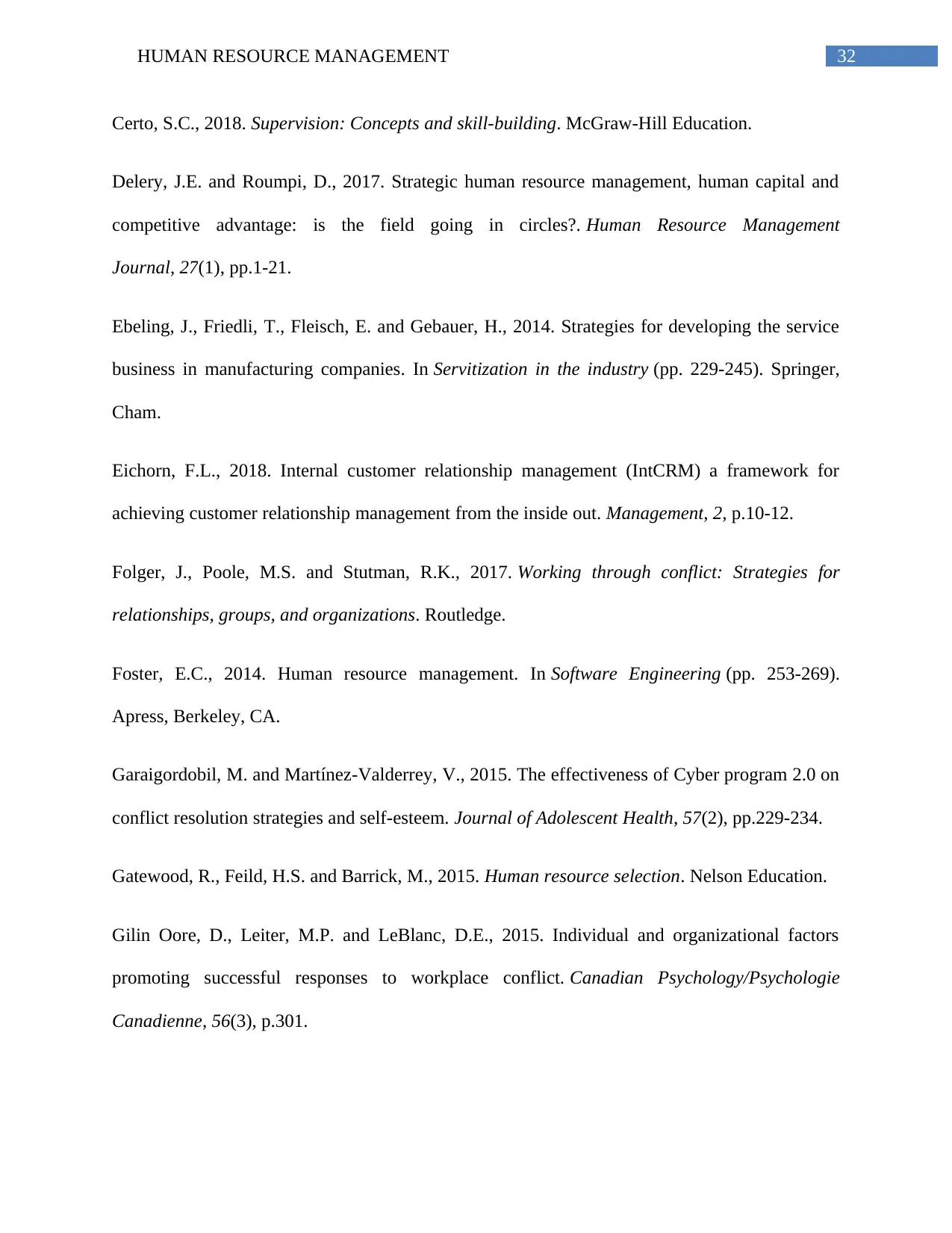
32HUMAN RESOURCE MANAGEMENT
Certo, S.C., 2018. Supervision: Concepts and skill-building. McGraw-Hill Education.
Delery, J.E. and Roumpi, D., 2017. Strategic human resource management, human capital and
competitive advantage: is the field going in circles?. Human Resource Management
Journal, 27(1), pp.1-21.
Ebeling, J., Friedli, T., Fleisch, E. and Gebauer, H., 2014. Strategies for developing the service
business in manufacturing companies. In Servitization in the industry (pp. 229-245). Springer,
Cham.
Eichorn, F.L., 2018. Internal customer relationship management (IntCRM) a framework for
achieving customer relationship management from the inside out. Management, 2, p.10-12.
Folger, J., Poole, M.S. and Stutman, R.K., 2017. Working through conflict: Strategies for
relationships, groups, and organizations. Routledge.
Foster, E.C., 2014. Human resource management. In Software Engineering (pp. 253-269).
Apress, Berkeley, CA.
Garaigordobil, M. and Martínez-Valderrey, V., 2015. The effectiveness of Cyber program 2.0 on
conflict resolution strategies and self-esteem. Journal of Adolescent Health, 57(2), pp.229-234.
Gatewood, R., Feild, H.S. and Barrick, M., 2015. Human resource selection. Nelson Education.
Gilin Oore, D., Leiter, M.P. and LeBlanc, D.E., 2015. Individual and organizational factors
promoting successful responses to workplace conflict. Canadian Psychology/Psychologie
Canadienne, 56(3), p.301.
Certo, S.C., 2018. Supervision: Concepts and skill-building. McGraw-Hill Education.
Delery, J.E. and Roumpi, D., 2017. Strategic human resource management, human capital and
competitive advantage: is the field going in circles?. Human Resource Management
Journal, 27(1), pp.1-21.
Ebeling, J., Friedli, T., Fleisch, E. and Gebauer, H., 2014. Strategies for developing the service
business in manufacturing companies. In Servitization in the industry (pp. 229-245). Springer,
Cham.
Eichorn, F.L., 2018. Internal customer relationship management (IntCRM) a framework for
achieving customer relationship management from the inside out. Management, 2, p.10-12.
Folger, J., Poole, M.S. and Stutman, R.K., 2017. Working through conflict: Strategies for
relationships, groups, and organizations. Routledge.
Foster, E.C., 2014. Human resource management. In Software Engineering (pp. 253-269).
Apress, Berkeley, CA.
Garaigordobil, M. and Martínez-Valderrey, V., 2015. The effectiveness of Cyber program 2.0 on
conflict resolution strategies and self-esteem. Journal of Adolescent Health, 57(2), pp.229-234.
Gatewood, R., Feild, H.S. and Barrick, M., 2015. Human resource selection. Nelson Education.
Gilin Oore, D., Leiter, M.P. and LeBlanc, D.E., 2015. Individual and organizational factors
promoting successful responses to workplace conflict. Canadian Psychology/Psychologie
Canadienne, 56(3), p.301.
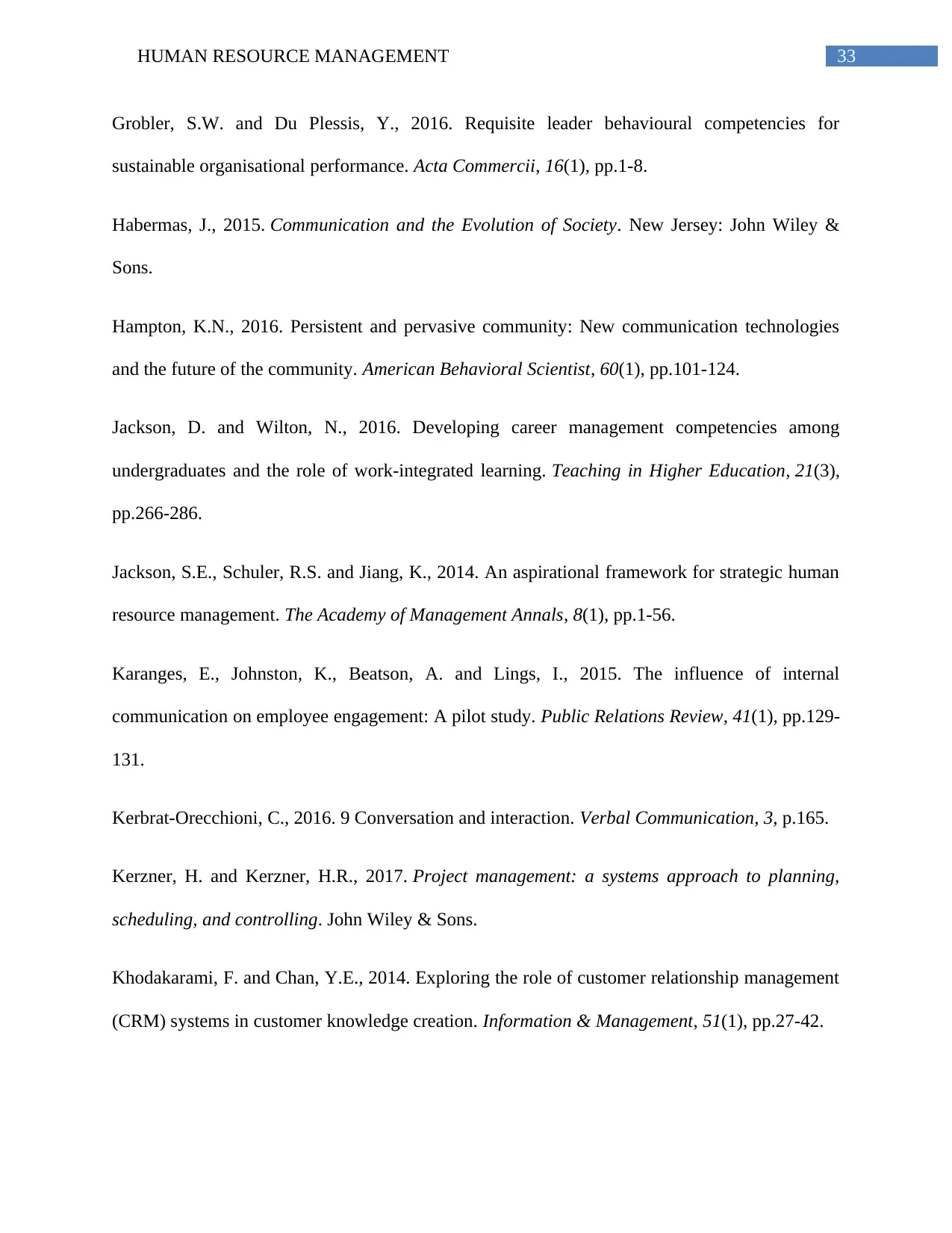
33HUMAN RESOURCE MANAGEMENT
Grobler, S.W. and Du Plessis, Y., 2016. Requisite leader behavioural competencies for
sustainable organisational performance. Acta Commercii, 16(1), pp.1-8.
Habermas, J., 2015. Communication and the Evolution of Society. New Jersey: John Wiley &
Sons.
Hampton, K.N., 2016. Persistent and pervasive community: New communication technologies
and the future of the community. American Behavioral Scientist, 60(1), pp.101-124.
Jackson, D. and Wilton, N., 2016. Developing career management competencies among
undergraduates and the role of work-integrated learning. Teaching in Higher Education, 21(3),
pp.266-286.
Jackson, S.E., Schuler, R.S. and Jiang, K., 2014. An aspirational framework for strategic human
resource management. The Academy of Management Annals, 8(1), pp.1-56.
Karanges, E., Johnston, K., Beatson, A. and Lings, I., 2015. The influence of internal
communication on employee engagement: A pilot study. Public Relations Review, 41(1), pp.129-
131.
Kerbrat-Orecchioni, C., 2016. 9 Conversation and interaction. Verbal Communication, 3, p.165.
Kerzner, H. and Kerzner, H.R., 2017. Project management: a systems approach to planning,
scheduling, and controlling. John Wiley & Sons.
Khodakarami, F. and Chan, Y.E., 2014. Exploring the role of customer relationship management
(CRM) systems in customer knowledge creation. Information & Management, 51(1), pp.27-42.
Grobler, S.W. and Du Plessis, Y., 2016. Requisite leader behavioural competencies for
sustainable organisational performance. Acta Commercii, 16(1), pp.1-8.
Habermas, J., 2015. Communication and the Evolution of Society. New Jersey: John Wiley &
Sons.
Hampton, K.N., 2016. Persistent and pervasive community: New communication technologies
and the future of the community. American Behavioral Scientist, 60(1), pp.101-124.
Jackson, D. and Wilton, N., 2016. Developing career management competencies among
undergraduates and the role of work-integrated learning. Teaching in Higher Education, 21(3),
pp.266-286.
Jackson, S.E., Schuler, R.S. and Jiang, K., 2014. An aspirational framework for strategic human
resource management. The Academy of Management Annals, 8(1), pp.1-56.
Karanges, E., Johnston, K., Beatson, A. and Lings, I., 2015. The influence of internal
communication on employee engagement: A pilot study. Public Relations Review, 41(1), pp.129-
131.
Kerbrat-Orecchioni, C., 2016. 9 Conversation and interaction. Verbal Communication, 3, p.165.
Kerzner, H. and Kerzner, H.R., 2017. Project management: a systems approach to planning,
scheduling, and controlling. John Wiley & Sons.
Khodakarami, F. and Chan, Y.E., 2014. Exploring the role of customer relationship management
(CRM) systems in customer knowledge creation. Information & Management, 51(1), pp.27-42.
Paraphrase This Document
Need a fresh take? Get an instant paraphrase of this document with our AI Paraphraser

34HUMAN RESOURCE MANAGEMENT
Kinloch, P. and Metge, J., 2014. Talking past each other: problems of cross-cultural
communication. Victoria University Press.
Kramar, R., 2014. Beyond strategic human resource management: is sustainable human resource
management the next approach?. The International Journal of Human Resource
Management, 25(8), pp.1069-1089.
Kumar, V. and Reinartz, W., 2018. Customer relationship management: Concept, strategy, and
tools. Springer.
Law, R., Buhalis, D. and Cobanoglu, C., 2014. Progress on information and communication
technologies in hospitality and tourism. International Journal of Contemporary Hospitality
Management, 26(5), pp.727-750.
Lemonnier, P., 2016. Mundane objects: Materiality and non-verbal communication. Routledge.
Martin, J.N. and Nakayama, T.K., 2015. Reconsidering intercultural (communication)
competence in the workplace: A dialectical approach. Language and Intercultural
Communication, 15(1), pp.13-28.
Mathur, M. and Sh, H., 2016, September. A Study on Behavioural Competencies of the Z
Generation. In International Conference on Management and Information Systems September,
23(2), p. 24.
Megahed, N., 2015. Capturing Competencies and Behavioural Indicators of Diplomats for a
Multiple-Jobs Competency Model. Journal of Human Resources, 3(1), pp.54-78.
Mehrabian, A., 2017. Nonverbal communication. Abingdon: Routledge.
Kinloch, P. and Metge, J., 2014. Talking past each other: problems of cross-cultural
communication. Victoria University Press.
Kramar, R., 2014. Beyond strategic human resource management: is sustainable human resource
management the next approach?. The International Journal of Human Resource
Management, 25(8), pp.1069-1089.
Kumar, V. and Reinartz, W., 2018. Customer relationship management: Concept, strategy, and
tools. Springer.
Law, R., Buhalis, D. and Cobanoglu, C., 2014. Progress on information and communication
technologies in hospitality and tourism. International Journal of Contemporary Hospitality
Management, 26(5), pp.727-750.
Lemonnier, P., 2016. Mundane objects: Materiality and non-verbal communication. Routledge.
Martin, J.N. and Nakayama, T.K., 2015. Reconsidering intercultural (communication)
competence in the workplace: A dialectical approach. Language and Intercultural
Communication, 15(1), pp.13-28.
Mathur, M. and Sh, H., 2016, September. A Study on Behavioural Competencies of the Z
Generation. In International Conference on Management and Information Systems September,
23(2), p. 24.
Megahed, N., 2015. Capturing Competencies and Behavioural Indicators of Diplomats for a
Multiple-Jobs Competency Model. Journal of Human Resources, 3(1), pp.54-78.
Mehrabian, A., 2017. Nonverbal communication. Abingdon: Routledge.
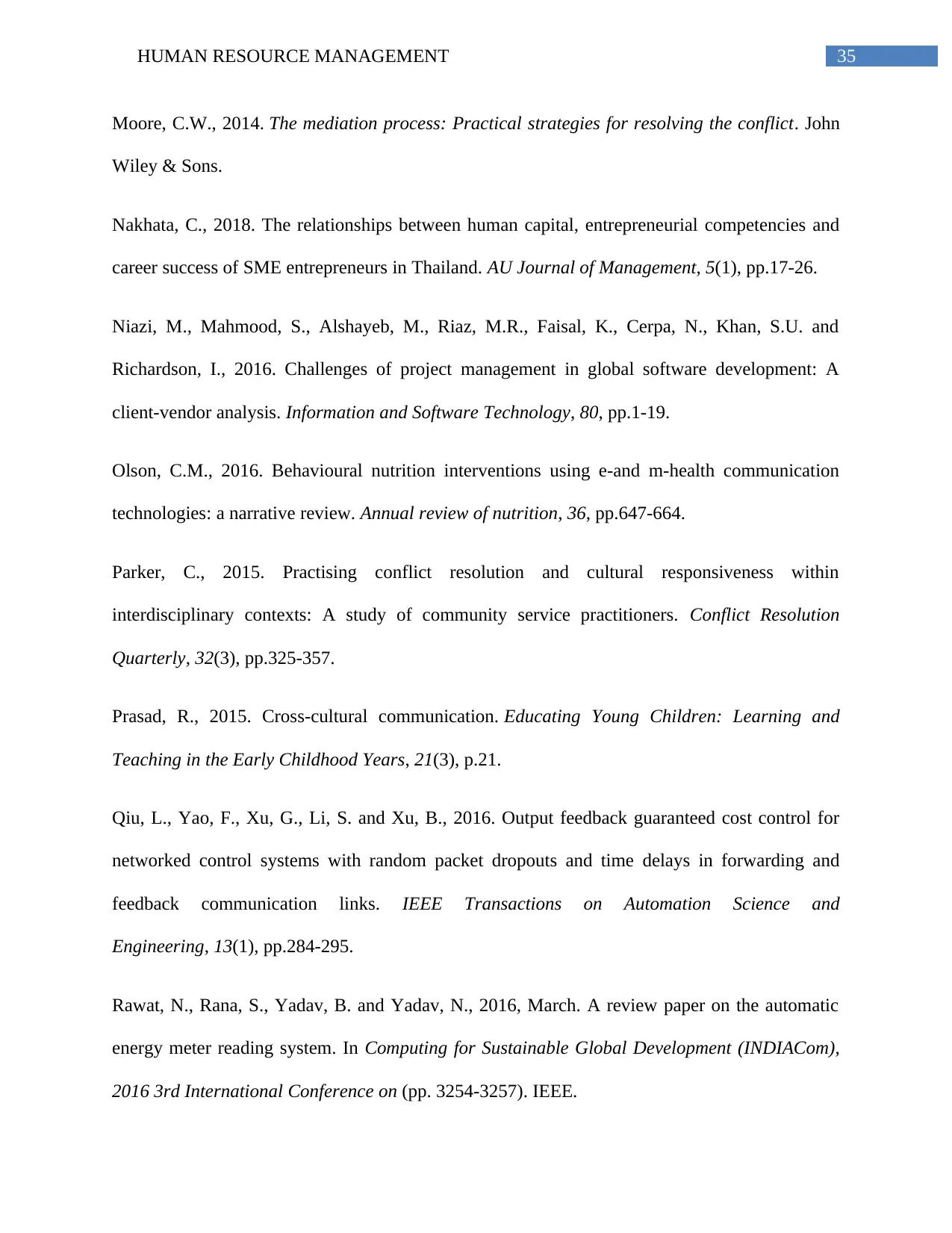
35HUMAN RESOURCE MANAGEMENT
Moore, C.W., 2014. The mediation process: Practical strategies for resolving the conflict. John
Wiley & Sons.
Nakhata, C., 2018. The relationships between human capital, entrepreneurial competencies and
career success of SME entrepreneurs in Thailand. AU Journal of Management, 5(1), pp.17-26.
Niazi, M., Mahmood, S., Alshayeb, M., Riaz, M.R., Faisal, K., Cerpa, N., Khan, S.U. and
Richardson, I., 2016. Challenges of project management in global software development: A
client-vendor analysis. Information and Software Technology, 80, pp.1-19.
Olson, C.M., 2016. Behavioural nutrition interventions using e-and m-health communication
technologies: a narrative review. Annual review of nutrition, 36, pp.647-664.
Parker, C., 2015. Practising conflict resolution and cultural responsiveness within
interdisciplinary contexts: A study of community service practitioners. Conflict Resolution
Quarterly, 32(3), pp.325-357.
Prasad, R., 2015. Cross-cultural communication. Educating Young Children: Learning and
Teaching in the Early Childhood Years, 21(3), p.21.
Qiu, L., Yao, F., Xu, G., Li, S. and Xu, B., 2016. Output feedback guaranteed cost control for
networked control systems with random packet dropouts and time delays in forwarding and
feedback communication links. IEEE Transactions on Automation Science and
Engineering, 13(1), pp.284-295.
Rawat, N., Rana, S., Yadav, B. and Yadav, N., 2016, March. A review paper on the automatic
energy meter reading system. In Computing for Sustainable Global Development (INDIACom),
2016 3rd International Conference on (pp. 3254-3257). IEEE.
Moore, C.W., 2014. The mediation process: Practical strategies for resolving the conflict. John
Wiley & Sons.
Nakhata, C., 2018. The relationships between human capital, entrepreneurial competencies and
career success of SME entrepreneurs in Thailand. AU Journal of Management, 5(1), pp.17-26.
Niazi, M., Mahmood, S., Alshayeb, M., Riaz, M.R., Faisal, K., Cerpa, N., Khan, S.U. and
Richardson, I., 2016. Challenges of project management in global software development: A
client-vendor analysis. Information and Software Technology, 80, pp.1-19.
Olson, C.M., 2016. Behavioural nutrition interventions using e-and m-health communication
technologies: a narrative review. Annual review of nutrition, 36, pp.647-664.
Parker, C., 2015. Practising conflict resolution and cultural responsiveness within
interdisciplinary contexts: A study of community service practitioners. Conflict Resolution
Quarterly, 32(3), pp.325-357.
Prasad, R., 2015. Cross-cultural communication. Educating Young Children: Learning and
Teaching in the Early Childhood Years, 21(3), p.21.
Qiu, L., Yao, F., Xu, G., Li, S. and Xu, B., 2016. Output feedback guaranteed cost control for
networked control systems with random packet dropouts and time delays in forwarding and
feedback communication links. IEEE Transactions on Automation Science and
Engineering, 13(1), pp.284-295.
Rawat, N., Rana, S., Yadav, B. and Yadav, N., 2016, March. A review paper on the automatic
energy meter reading system. In Computing for Sustainable Global Development (INDIACom),
2016 3rd International Conference on (pp. 3254-3257). IEEE.
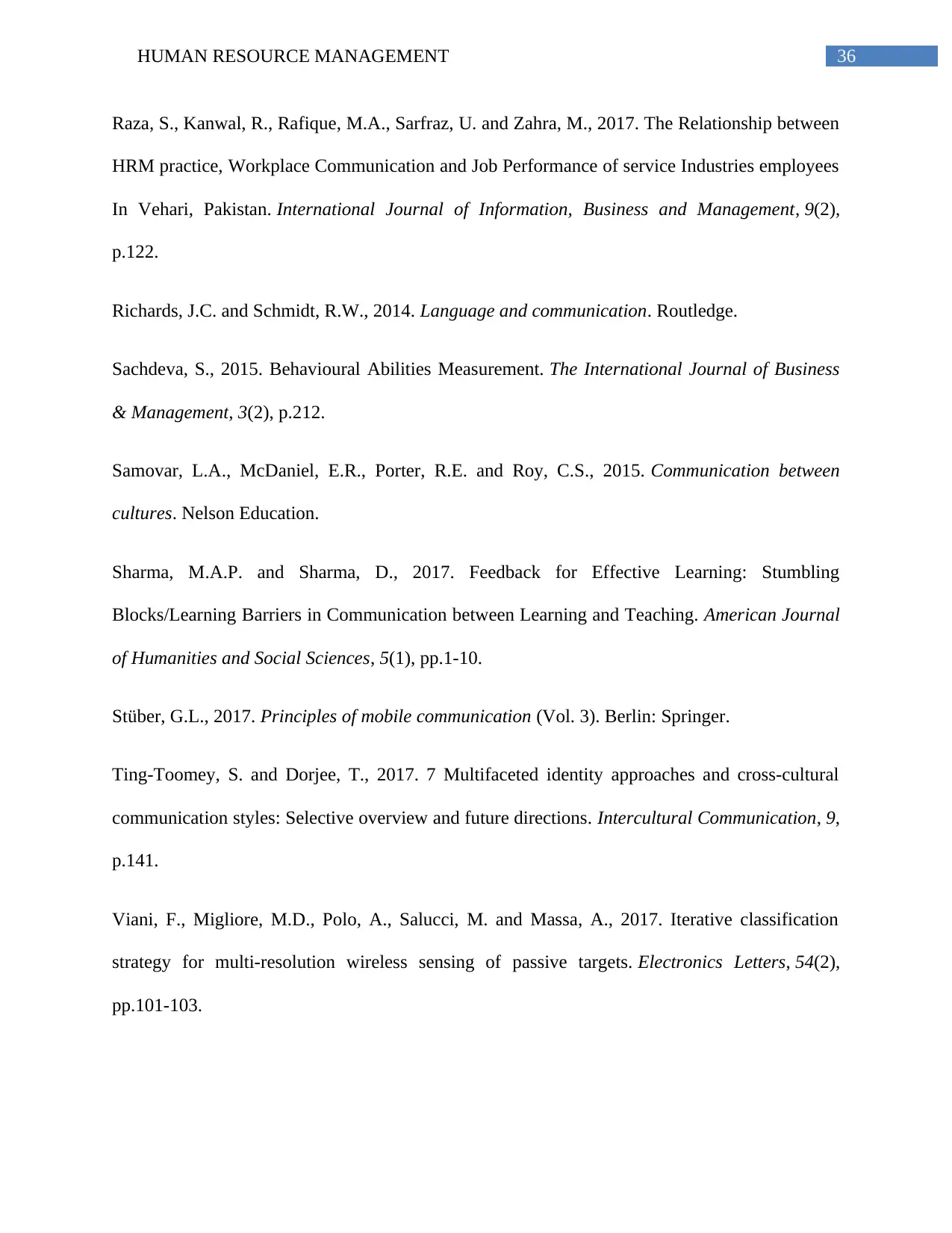
36HUMAN RESOURCE MANAGEMENT
Raza, S., Kanwal, R., Rafique, M.A., Sarfraz, U. and Zahra, M., 2017. The Relationship between
HRM practice, Workplace Communication and Job Performance of service Industries employees
In Vehari, Pakistan. International Journal of Information, Business and Management, 9(2),
p.122.
Richards, J.C. and Schmidt, R.W., 2014. Language and communication. Routledge.
Sachdeva, S., 2015. Behavioural Abilities Measurement. The International Journal of Business
& Management, 3(2), p.212.
Samovar, L.A., McDaniel, E.R., Porter, R.E. and Roy, C.S., 2015. Communication between
cultures. Nelson Education.
Sharma, M.A.P. and Sharma, D., 2017. Feedback for Effective Learning: Stumbling
Blocks/Learning Barriers in Communication between Learning and Teaching. American Journal
of Humanities and Social Sciences, 5(1), pp.1-10.
Stüber, G.L., 2017. Principles of mobile communication (Vol. 3). Berlin: Springer.
Ting-Toomey, S. and Dorjee, T., 2017. 7 Multifaceted identity approaches and cross-cultural
communication styles: Selective overview and future directions. Intercultural Communication, 9,
p.141.
Viani, F., Migliore, M.D., Polo, A., Salucci, M. and Massa, A., 2017. Iterative classification
strategy for multi-resolution wireless sensing of passive targets. Electronics Letters, 54(2),
pp.101-103.
Raza, S., Kanwal, R., Rafique, M.A., Sarfraz, U. and Zahra, M., 2017. The Relationship between
HRM practice, Workplace Communication and Job Performance of service Industries employees
In Vehari, Pakistan. International Journal of Information, Business and Management, 9(2),
p.122.
Richards, J.C. and Schmidt, R.W., 2014. Language and communication. Routledge.
Sachdeva, S., 2015. Behavioural Abilities Measurement. The International Journal of Business
& Management, 3(2), p.212.
Samovar, L.A., McDaniel, E.R., Porter, R.E. and Roy, C.S., 2015. Communication between
cultures. Nelson Education.
Sharma, M.A.P. and Sharma, D., 2017. Feedback for Effective Learning: Stumbling
Blocks/Learning Barriers in Communication between Learning and Teaching. American Journal
of Humanities and Social Sciences, 5(1), pp.1-10.
Stüber, G.L., 2017. Principles of mobile communication (Vol. 3). Berlin: Springer.
Ting-Toomey, S. and Dorjee, T., 2017. 7 Multifaceted identity approaches and cross-cultural
communication styles: Selective overview and future directions. Intercultural Communication, 9,
p.141.
Viani, F., Migliore, M.D., Polo, A., Salucci, M. and Massa, A., 2017. Iterative classification
strategy for multi-resolution wireless sensing of passive targets. Electronics Letters, 54(2),
pp.101-103.
Secure Best Marks with AI Grader
Need help grading? Try our AI Grader for instant feedback on your assignments.
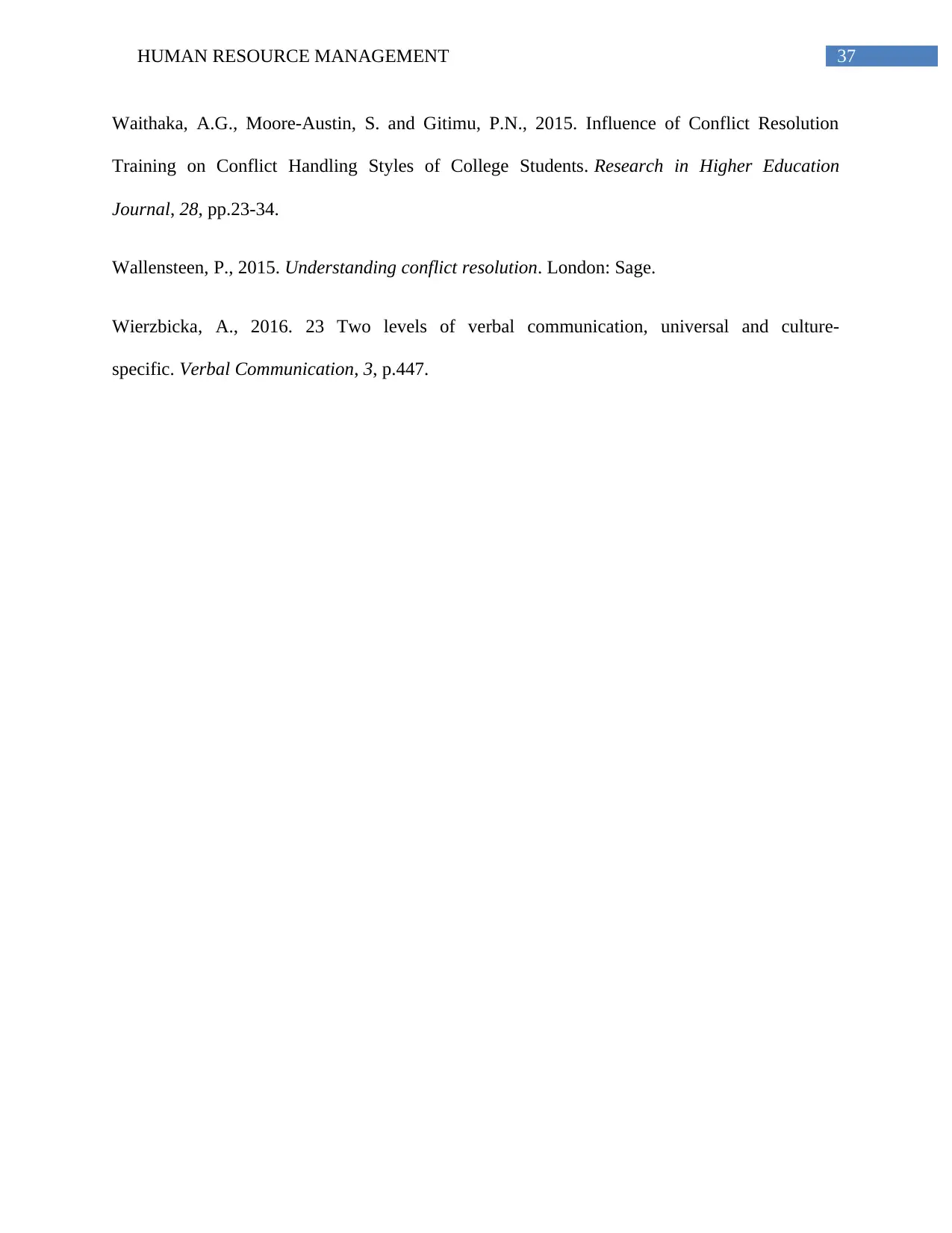
37HUMAN RESOURCE MANAGEMENT
Waithaka, A.G., Moore-Austin, S. and Gitimu, P.N., 2015. Influence of Conflict Resolution
Training on Conflict Handling Styles of College Students. Research in Higher Education
Journal, 28, pp.23-34.
Wallensteen, P., 2015. Understanding conflict resolution. London: Sage.
Wierzbicka, A., 2016. 23 Two levels of verbal communication, universal and culture-
specific. Verbal Communication, 3, p.447.
Waithaka, A.G., Moore-Austin, S. and Gitimu, P.N., 2015. Influence of Conflict Resolution
Training on Conflict Handling Styles of College Students. Research in Higher Education
Journal, 28, pp.23-34.
Wallensteen, P., 2015. Understanding conflict resolution. London: Sage.
Wierzbicka, A., 2016. 23 Two levels of verbal communication, universal and culture-
specific. Verbal Communication, 3, p.447.
1 out of 38
Related Documents
Your All-in-One AI-Powered Toolkit for Academic Success.
+13062052269
info@desklib.com
Available 24*7 on WhatsApp / Email
![[object Object]](/_next/static/media/star-bottom.7253800d.svg)
Unlock your academic potential
© 2024 | Zucol Services PVT LTD | All rights reserved.




